Table of Contents
Probably all of you have heard the word superfood before. It is probably somewhat apparent to you that these are foods that are beneficial to your health and should be a regular part of your diet. However, this does not mean that by simply eating superfoods you’ll gain super health with a hint of immortality. You need to focus on your overall lifestyle. And it is these nutritionally packed foods that help propel your diet to the next level.
In today’s article, we will discuss which superfoods are the best, what they contain and what benefits can be expected from them.
What are superfoods?
Under the term “superfood” everybody has a different perspective. Some people immediately think of green algae such as spirulina, others think of avocados, and yet others think of blueberries. In general, they would all be correct. A superfood can be defined as virtually any raw food that has a high content of health-promoting substances. As a rule, these are usually vitamins, minerals or antioxidants such as polyphenols. As such, it is possible to consider fruits, vegetables and other foods that you have at home and normally eat, for example, in porridge or a lunch salad, as superfoods.
Well, sure, but how do you know what is a superfood and what is not? Basically, there are no regulations or legislation to determine what is a superfood and what is not. That’s why it’s a good idea to find out what foods actually contain so that you can judge for yourself the potential positive impact on your health.[1]
That’s why we’ve prepared a comprehensive list of some superfoods that you definitely won’t go wrong with and are worth eating regularly. But there are also many other nutritionally rich foods. That’s why it’s ideal to have a varied and as colourful a diet as possible to make the most of every meal.
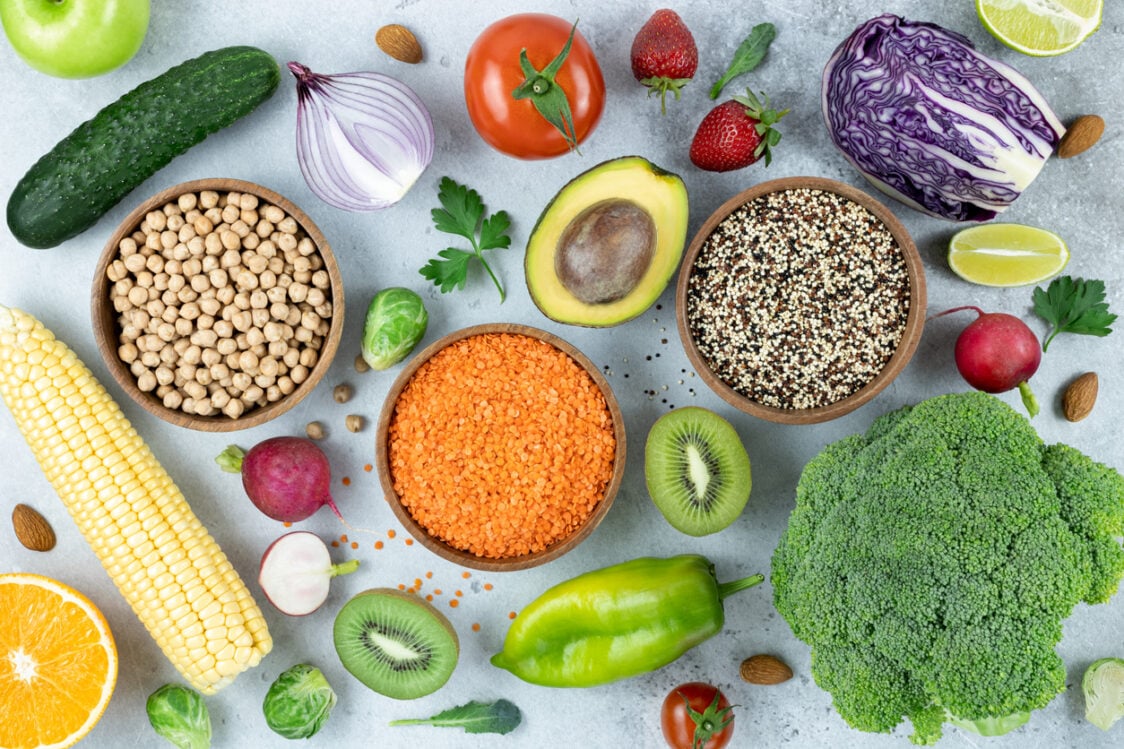
What kinds of superfoods are available?
For better clarity, we have divided the superfoods into several subcategories, from which we have selected a few popular choices.
Fruit
Among fruit, you will find different types of superfoods that differ in colour, taste, form and availability. It is up to you whether you choose fresh fruit, dried fruit, frozen fruit, canned fruit or concentrated powders.
In this section, you’ll learn more about these superfoods:
1. Goji
Goji is the dried fruit of a plant called Lycium chinense. You may also know them as wolf berries. These are small red berries that are interesting in their taste, nutritional profile and history. They have a tradition especially in China, where they have been used in traditional Chinese medicine for more than 2,000 years. Locals believe that they can have a positive impact on longevity and overall well-being. In addition to eating them fresh, they are also often eaten when dried. Due to their many benefits, however, they are also popular in the form of juice or powder, which are concentrated sources of beneficial substances.[3]
Benefits of goji
- They improve immunological reactions, making your defences stronger and more effective.
- In addition, they also have an effect on the health of the eyes, especially the retina. In addition, they help to protect the lens and retina from damage.
- One study actually found that drinking goji concentrate for as little as 14 days led to improvements in overall well-being, energy levels, athletic performance, sleep quality, and gastrointestinal function.[4–8]
What beneficial substances do goji berries contain?
Goji are especially known for their high content of vitamin C, fibre, vitamin A and iron. Moreover, they also contain bioactive substances such as polysaccharides, carotenoids and phenols.[2]
Average nutritional values of goji
| Energy value | 329 kcal |
| Carbohydrates | 67.9 g |
| Protein | 42.8 g |
| Fat | 0 g |
| Fibre | 7.1 g |
What can you prepare with goji berries and how to incorporate them into your diet?
- gluten-free raw doughnuts with chocolate glaze
- can be added to porridge, salads or as a garnish for desserts
2. Blueberries
Blueberries (Vaccinium myrtillus) are one of a select few fruits that are naturally blue in colour. This is due to their anthocyanin content, which gives them this attractive appearance. This is one of the reasons why they are so popular all over the world. They have been eaten for several thousand years. In North America, they were even called star fruit because they have a small star on the end of the berry blossom. They are popular not only for their appearance but also for their nutritional profile and taste.[9]
Benefits of blueberries
- Scientific studies have shown that they can have a positive effect on a number of cognitive functions. For example, they can slow their decline and improve memory. This is why they are often classified as nootropics.
- Thanks to antioxidants they help reduce DNA damage, which can slow down the ageing process, while also acting to some extent as an aid in preventing the development of cancer or in boosting immunity and suppressing inflammation.
- It appears that blueberries could also positively influence insulin sensitivity and glucose metabolism, which could benefit diabetics. They also have an effect on heart health.[10–14]
What beneficial substances do blueberries contain?
Blueberries are rich in antioxidants such as quercetin, resveratrol and myricetin. However, they also contain other important substances such as vitamin C, E, K, B6 and manganese.[2][15]
Average nutritional values of blueberries
| Energy value | 59 kcal |
| Carbohydrates | 12.1 g |
| Protein | 0.8 g |
| Fat | 0.3 g |
| Fibre | 2.4 g |
What can you prepare with blueberries and how to incorporate them into your diet?
- oatmeal cake with blueberries
- refreshing blueberry slices packed with protein
- crumble cake with quark, blueberries and strawberries
- kefir bundt cake with blueberries
- tiramisu with soft cream and berries
- smoothie
- fluffy sponge slice with fruit
- add to other desserts or breakfast porridge
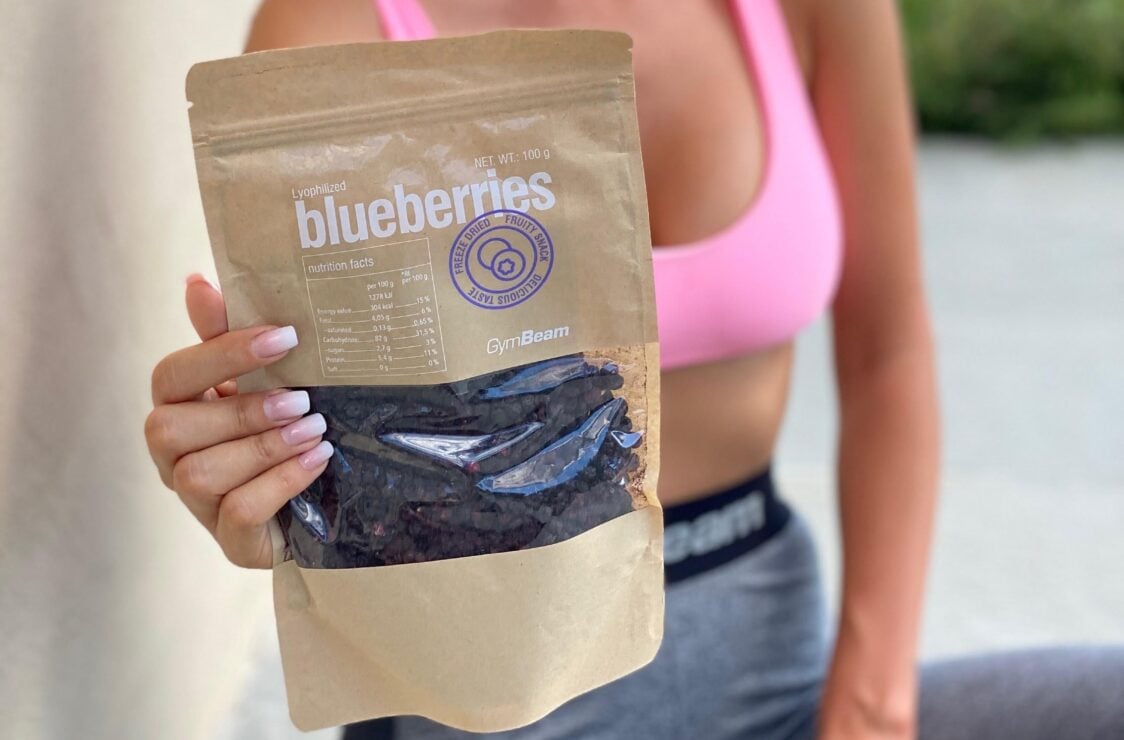
3. Raspberries
The specific taste of raspberries (Rubus idaeus) is simply irreplaceable. But did you know that in the Middle Ages they were also used to dye clothes? Today, you probably wouldn’t get away with that, so would prefer to use them to create tempting dishes. You may feel that there are no more than one kind of raspberry, but that’s not true. In fact, there are up to 200 different varieties that vary in size and colour. With this, you can easily experiment with them.[20]
Benefits of raspberries
- They have an effect on heart health and can have a positive effect on high blood pressure.
- Thanks to polyphenols they have anti-inflammatory, antioxidant and analgesic effects.
- They can also help protect the skin from UVB rays.
- Thanks to antioxidants and vitamins, they can have a positive effect on brain function.
- To some extent, they can help prevent the development of certain types of cancer.
- For those with diabetes they can help regulate glycaemia levels.
- They are used in anti-ageing.
- They can also help you control your weight.
- They may have an impact on eye health – helping to prevent macular degeneration.[21–26][235]
What beneficial substances do raspberries contain?
Raspberries are known in particular for their vitamin C and manganese content. However, they also contain vitamin B, potassium, antioxidants such as polyphenols (resveratrol), lutein, lycopene and zeaxanthin. And the popular raspberry ketones are not lacking either.[2][27]
Average nutritional values of raspberries
| Energy value | 45 kcal |
| Carbohydrates | 5.4 g |
| Protein | 1.2 g |
| Fat | 0.65 g |
| Fibre | 6.5 g |
What can you prepare with raspberries and how to incorporate them into your diet?
- raspberry tiramisu in a glass
- cottage raspberry ice cream
- sweet couscous with poppy seeds and raspberries
- kaiserschmarrn (torn pancakes) with raspberries
- moist muffins with chocolate and raspberry flavour
- no-bake cheesecake with raspberries
- French toast with quark and raspberries
- fresh chickpea blondies with raspberries and chocolate
- baked chocolate donuts with raspberries
- vegan almond slices with fluffy raspberry cream
- protein pudding with chia seeds and raspberries
4. Strawberries
Juicy strawberries (Fragaria vesca) inherently are a summer staple, as they can be incorporated into refreshing recipes. You may be surprised to learn that strawberries are in the same family and subfamily as roses. From a layman’s point of view, these two seemingly different plants may be linked by their captivating scent and attractive colour. But not everyone perceives them as such; there is even a phobia of strawberries, called fragariaphobia. However, neither of us has it, which is why strawberries are happily included on the menu.[16]
Benefits of strawberries
- Strawberries can also reduce inflammation in obese people with osteoarthritis and improve their quality of life.
- They can help prevent cardiovascular disease.
- To some extent, they can help prevent the development of cancer.
- They support heart health.
- They have an effect on maintaining stable blood sugar levels.[17–19]
What beneficial substances do strawberries contain?
Strawberries are well known for their high vitamin C content. Plus, they also contain vitamin B9, manganese, potassium and more than 25 different beneficial anthocyanins.[2]
Average nutritional values of strawberries
| Energy value | 31 kcal |
| Carbohydrates | 5.68 g |
| Protein | 0.64 g |
| Fat | 0.22 g |
| Fibre | 2 g |
What can you prepare with strawberries and how to incorporate them into your diet?
- moist cake with strawberry cream
- no-bake cheesecake slice with strawberries
- easy-to-make strawberry cake made with oatmeal flour
- fluffy strawberry-protein roll with coconut
- sponge cake with cream cheese and strawberries
- homemade fruit ice cream with strawberries and bananas
- vanilla cupcakes with strawberries and cream
- homemade strawberry jam with chia seeds
- no-bake nut balls with strawberry flavour
- homemade strawberry jam with chia seeds

5. Acai
Acai (Euterpe oleracea) belongs among the superfoods, which are packed with many nutritionally beneficial substances. They contain more antioxidants than blueberries. You can obtain them in their most concentrated form when you add the powder of this fruit to your meals. This delicious, blueberry-like fruit can be harder to find in some countries. They are, however, considered to be the fruit of longevity, so you should certainly not take their abilities lightly. You can enjoy them in any form.
Benefits of acai
- It is beneficial for the brain and appears to help protect it from developing various diseases such as Alzheimer’s and Parkinson’s.
- It can help lower cholesterol levels.
- It can reduce the risk of developing colon cancer.
- Helps to stimulate immune function.[28–31]
What beneficial substances does acai contain?
You can find antioxidants (anthocyanins, proanthocyanidins and polyphenols) in acai berries. However, they do not lack calcium and vitamin A.[2]
Average nutritional values of acai
Values refer to 100 g of acai powder
| Energy value | 534 kcal |
| Carbohydrates | 8.5 g |
| Protein | 8.6 g |
| Fat | 44.5 g |
| Fibre | 32.5 |
What can you prepare with acai and how to incorporate it into your diet?
- delicious chocolate covered coconut balls
- smoothie
- breakfast porridge
- desserts
What other fruits are superfoods?
- Blackberries (Rubus fruticosus) are rich in potassium, manganese, magnesium and vitamins C, E and K. They certainly do not lack in flavonoids either. Thanks to their composition, they can have a positive effect on reducing the risk of cancer and also help to prevent gum infections.
- The avocado (Persea americana) is a fruit, but it is regarded as a good source of healthy fats. In addition, it also contains vitamins C, E, K, B9, B3, magnesium, potassium and copper. It is beneficial for people with diabetes who are trying to regulate their blood sugar levels. It also helps lower cholesterol levels.
- Physalis or mochina (Physalis peruviana) is a fruit rich in calcium, iron, sodium, vitamin C, vitamin A and many antioxidants. It can help support immunity or the digestive system.[32–34]
You might be interested in these products:
Vegetables
Vegetables, like fruit, can be consumed in many forms. Some people prefer fresh, others prefer frozen or sterilised. Whichever type you prefer, it is ideal to include foods of different colours to get the most out of your vegetables. Vegetables have many benefits, so you may want to include more of them in your diet after reading about them.
In this section, you’ll learn more about these superfoods:
1. Broccoli
Everybody is familiar with broccoli (Brassica oleracea). However, not all of you may know that its name more than likely comes from the Italian word broccolo, which loosely translates to a flowering top of cabbage. It thrives best in spring and autumn, making it perfect for warm baked dishes or soups in winter.[35]
Benefits of broccoli
- It can help people with diabetes maintain stable blood sugar levels.
- It has a positive effect on the functioning of the heart and the entire cardiovascular system.
- It has a positive effect on eye health.
- It is also beneficial in preventing the development of cancer.
- Helps protect cells from oxidative stress.[36–39]
What beneficial substances does broccoli contain?
Broccoli is especially rich in vitamin C and vitamin K. However, it also contains folic acid, potassium, magnesium, phosphorus, iron and a number of antioxidants, such as sulforaphane.[2][40]
Average nutritional values of broccoli
| Energy value | 36 kcal |
| Carbohydrates | 4 g |
| Protein | 2.82 g |
| Fat | 0.37 g |
| Fibre | 2.6 g |
What can you prepare with broccoli and how to incorporate it into your diet?
- seitan noodles with broccoli in Asian sauce
- cauliflower and broccoli pancakes
- Italian sweet potato frittata
- sweet potato bowl with tofu and cashew dressing
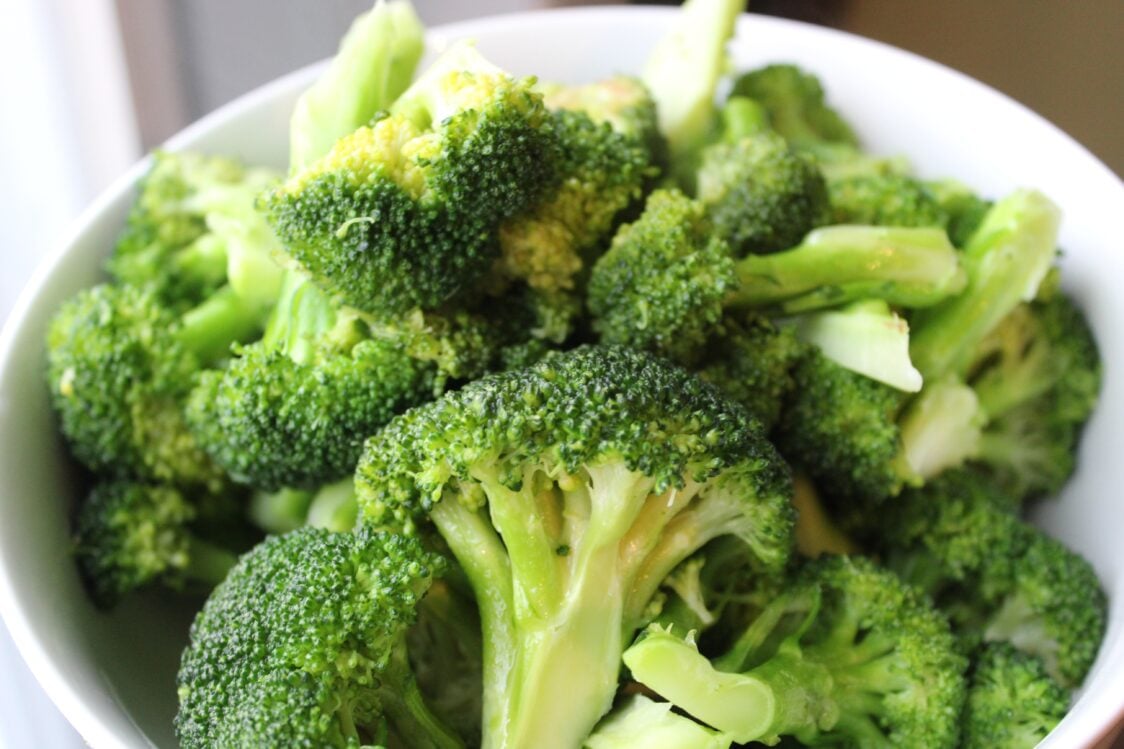
2. Beetroot
Beetroot (Beta vulgaris) is a superfood that can give colour to any dish perfectly. In ancient times it was even considered an aphrodisiac, which added to its popularity. And no wonder, it contains nitrates that affect the formation of nitric oxide. These then affect blood flow, which can have a positive impact on erections, for example. In some cultures, it was even believed that if a man and a woman ate the same beet, they would fall in love. In addition, beetroot is also a fine pre-workout for performance support.[41]
Benefits of beetroot
- It has a positive effect on your immunity.
- It can have a positive effect on athletic performance, thanks to its high nitrate content.
- It can help lower high blood pressure.
- It is used to fight inflammation.
- It is beneficial for brain health.
- Helps protect cells from oxidative stress.[42–47]
What beneficial substances does beetroot contain?
Beetroot contains many beneficial substances, including folic acid, iron, manganese, potassium, vitamin C and vitamin A. It also contains nitrates and the pigment betanin, a beneficial antioxidant.[2][48]
Average nutritional values of beetroot
| Energy value | 41 kcal |
| Carbohydrates | 6.76 g |
| Protein | 1.61 g |
| Fat | 0.17 g |
| Fibre | 2.8 g |
What can you prepare with beetroot and how to incorporate it into your diet?
- beetroot and apple salad
- beetroot and quark spread
- chickpea and beetroot hummus
- chocolate beetroot brownies
- beetroot brownies with quark cheese frosting
- red velvet cake with quark
3. Fermented vegetables
Preparing fermented vegetables is a great way to get the most out of the ingredients you use. During this process, sugar and starch in vegetables are broken down by bacteria and yeasts into alcohol and acids. There is also a growth of health-promoting bacteria known as probiotics. Thus, fermented vegetables are especially appreciated by your microbiome. The most common example is fermented cabbage or Korean kimchi, but you can ferment virtually any vegetable.[49]
Benefits of fermented vegetables
- They benefit your digestion as it is an important source of probiotics and prebiotics.
- They promote the growth and composition of intestinal bacteria – the microbiome (intestinal microflora).
- They are easier to digest than raw vegetables. This is because it breaks down (“pre-digests”) to some extent during fermentation.
- Depending on the type of vegetables used, you can also count on other benefits that vegetables have in general (fighting oxidative stress, supporting immunity, cardiovascular system, etc.).[50]
What beneficial substances are contained in fermented vegetables?
Fermented vegetables boast a particularly high content of probiotics and prebiotics. In addition, it also has a number of vitamins and minerals depending on which types you use.
Nutritional values of fermented vegetables
The nutritional value of fermented vegetables will vary depending on which you use. If you want to know the specific nutritional value of your mix, we recommend that you look up the exact nutritional value of each vegetable and calculate its nutritional value. After fermentation, they will not substantially differ.
What can you prepare with fermented vegetables and how can you incorporate them into your diet?
- add them to a salad or use them as a side dish to a main course
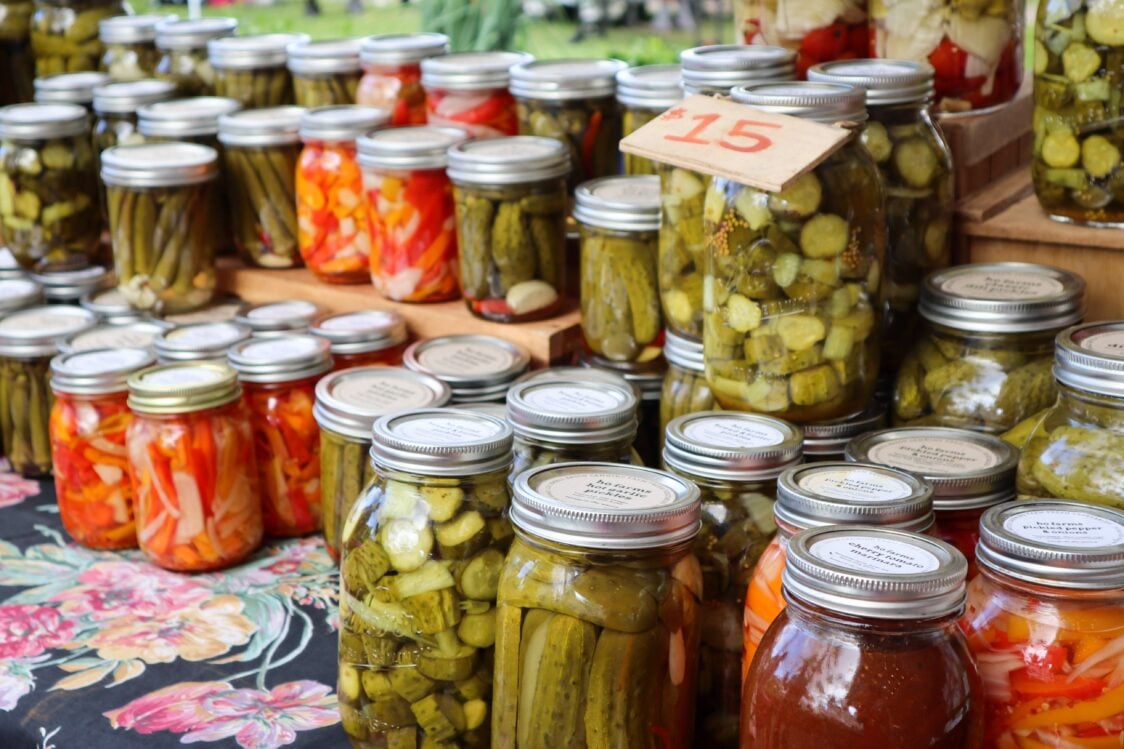
4. Dark leafy vegetables
This category includes spinach, chard, kale, turnips, arugula, cabbage and other green foods that have an undeniable positive impact on health. They differ in colour, so you can choose from several shades of green. In addition, they have a different taste and shape. Thanks to this, everyone will find the one that suits them best for a particular dish.
Benefits of dark leafy vegetables
- Help reduce oxidative stress.
- They have a positive effect on the immune system.
- Support healthy digestion.
- Are beneficial for heart health.
- Have a positive effect on cognitive functions.
- Help maintain normal blood sugar levels.[51–53]
What beneficial substances do dark leafy vegetables contain?
Green leafy vegetables are generally rich in vitamins, minerals and antioxidants such as phenols, flavonoids and carotenoids. Another benefit is their high proportion of fibre and low calorie content. This makes them a great choice not only for dieting but also as a normal part of a healthy lifestyle.[2]
Average nutritional values of spinach
| Energy value | 25 kcal |
| Carbohydrates | 1.43 g |
| Protein | 2.86 g |
| Fat | 0.39 g |
| Fibre | 2.2 g |
Average nutritional values of kale
| Energy value | 35 kcal |
| Carbohydrates | 0.3 g |
| Protein | 2.92 g |
| Fat | 1.49 |
| Fibre | 4.1 g |
Average nutritional values of arugula
| Energy value | 27 kcal |
| Carbohydrates | 2 g |
| Protein | 2.58 g |
| Fat | 0.66 g |
| Fibre | 1.6 g |
What can you prepare with dark leafy vegetables and how to incorporate them into your diet?
- chicken with pasta, spinach and cream sauce
- mushroom burgers with baby spinach
- spinach omelette filled with mushrooms
- spinach quiche – savoury French pie
- pumpkin gnocchi with tofu and spinach
- pumpkin quiche with spinach and mozzarella
- salty spinach pancakes filled with ricotta and salmon
- waffles with spinach and smoked salmon
- savoury carrot and spinach pancakes
- French savoury quiche in a fit version
- light quinoa salad in a glass
- cauliflower pizza with prosciutto and mozzarella
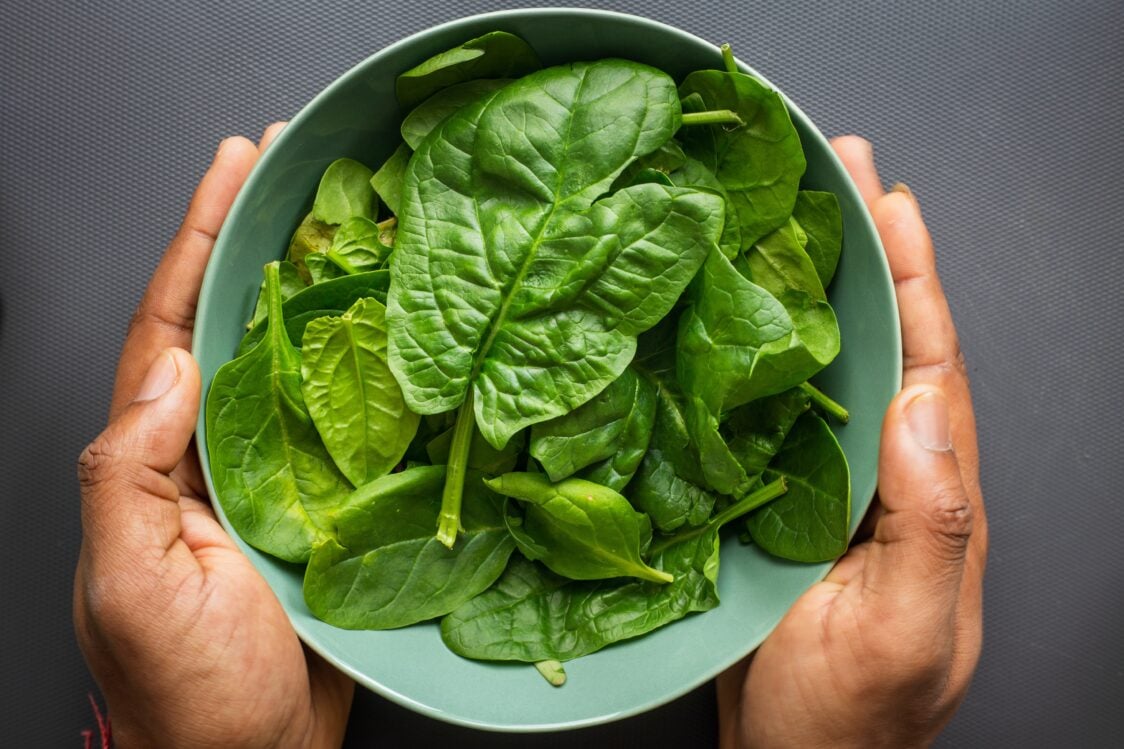
Green superfoods
Food in this category has been a hit in recent years. They are usually available in concentrated powder form, which makes them easy to ingest. You can add them to virtually any food or drink and benefit from a wide range of benefits. Like green leafy vegetables, these superfoods contain beneficial chlorophyll.
In this section, you’ll learn more about these superfoods:
1. Matcha
Matcha (Camellia sinensis) is a type of green tea that was introduced to us from Japan. It was there that it was formerly used as an aid for meditation. It was able to keep a person calm but at the same time in a state of maximum concentration. Samurai also drank matcha before important battles. Of course, you can benefit from the goodness of this Japanese tea even if there is no battle ahead. During a busy day, it is a super helper to cope with all the challenges.[54]
Benefits of matcha
- It stimulates the body, thanks to l-theanine there are no sharp energy fluctuations, as is the case with caffeine.
- Supports cognitive performance.
- Thanks to catechins (especially epigallocatechin gallate – EGCG), which act as powerful antioxidants, it helps protect cells from oxidative stress.
- It is also associated with a lower risk of developing cancer.
- It has a positive effect on liver health.
- It is anti-inflammatory and has a positive effect on skin quality.[55–57]
What beneficial substances does matcha contain?
Matcha is rich in caffeine, thanks to which many people use it as an alternative to coffee. However, it also contains antioxidants such as phenolic compounds, rutin and quercetin. However, it also has a decent proportion of l-theanine, chlorophyll (green pigment), tea catechins and vitamin C.[2][58]
Average nutritional values of matcha
The values are based on matcha powder from green tea leaves.
| Energy value | 305 kcal |
| Carbohydrates | 33.8 g |
| Protein | 24.8 g |
| Fat | 3.2 g |
| Fibre | 29.8 g |
What can you prepare with matcha and how to incorporate it into your diet?
- fluffy matcha cupcakes with quark
- refreshing non-alcoholic summer drinks
- best chia pudding recipes
- can be added to porridge, smoothies and other dishes and drinks
2. Chlorella
Chlorella (Chlorella vulgaris) is a microscopic algae that does not stand out for its size, but its beneficial nutrient content would put any of its competitors in the bag. It grows all over the world in freshwater. It is most commonly used in concentrated powder or tablet form, where its benefits can be easily gained.[59]
Benefits of chlorella
- It has a positive effect on your immunity.
- It is known for its antioxidant abilities.
- In people with diabetes, it helps to maintain stable sugar levels.
- Improves total cholesterol levels.
- It is beneficial for eye health.
- It has a positive effect on liver health.
- It participates in the natural detoxification process of the body.[59–60]
What beneficial substances does chlorella contain?
Chlorella is known for its high levels of vitamin C, D, B2, B3, B12 and iron. However, it also contains chlorophyll, antioxidants, proteins, fibre and omega-3 fatty acids.[2][61]
Average nutritional values of chlorella
Values are based on chlorella powder.
| Energy value | 343 kcal |
| Carbohydrates | 14 g |
| Protein | 61 g |
| Fat | 2.3 g |
| Fibre | 12 g |
What can you prepare with chlorella and how can you incorporate it into your diet?
- green protein porridge with Chlorella from only 4 ingredients
- gluten-free vegan buns with Chlorella
- smoothies
- can also be added to various doughs, which, in addition to nutrients, will also give an interesting colour
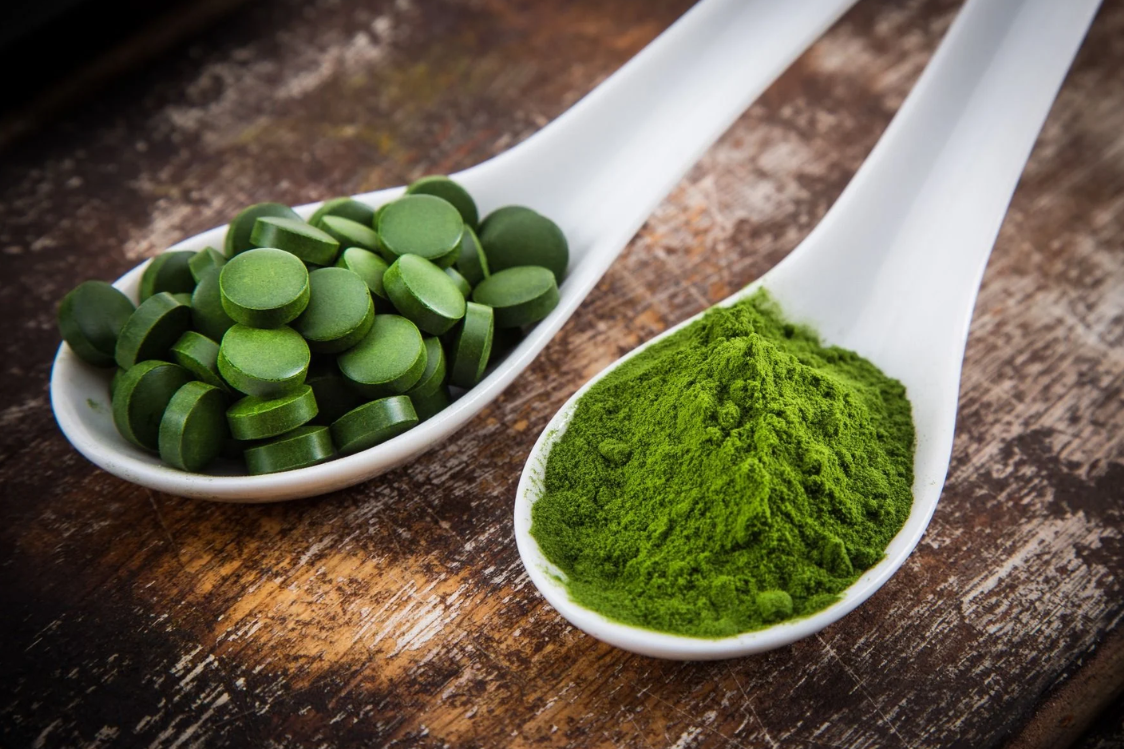
3. Spirulina
Spirulina (Arthrospira platensis) is one of the algae that is growing in popularity throughout the world of healthy eating. It has a blue-green colour and can be found in various types of water. However, if you want to include it in your diet, the easiest way will be to reach for tablets or powder. For centuries, it has been used to treat various diseases or to improve athletic endurance. However, there are many other reasons and benefits to including it in your diet on a regular basis.[62]
Benefits of spirulina
- It is used in the treatment of anaemia.
- It can support your defence mechanism.
- It works as an effective antioxidant.
- It is beneficial for liver health and can help reduce the risk of liver inflammation.
- It can help to maintain optimal cholesterol levels.
- It helps to lower blood pressure for those with hypertension.
- It has a positive effect on oxygen consumption during endurance sports, which can lead to better results.[63–68]
What beneficial substances does spirulina contain?
Spirulina is significant for its high content of protein, vitamins B1, B2, B3, B6, B12, iodine, copper, iron and various antioxidants (phycocyanin and zeaxanthin). As a result, it has an unquestionable impact on your health..[2][69–70]
Average nutritional values of spirulina
Values are based on spirulina powder.
| Energy value | 290 kcal |
| Carbohydrates | 23.9 g |
| Protein | 57.5 g |
| Fat | 7.7 g |
| Fibre | 3.6 g |
What can you prepare with spirulina and how can you incorporate it into your diet?
- smoothie
- porridge
- dessert doughs, creams
- drinks
4. Green barley
Barley (Hordeum vulgare) is generally considered one of the most important cereals in the world. When we talk about green barley, we mean barley grass, which is a young barley plant. If you want to make the most of its benefits, we recommend choosing a concentrated form of powder or tablets.
Benefits of green barley
- It may have a positive effect on cognitive function as it is classified as a nootropic.
- Thanks to its gamma-aminobutyric acid (GABA) content, it can help calm the mind and harmonise sleep.
- May support immune function.
- Promotes overall health and well-being.
- It acts as an antioxidant, helping to protect cells from oxidative stress.[71]
What beneficial substances does green barley contain?
Green barley is especially rich in protein, vitamin A, vitamin B2, iron, potassium and magnesium. However, its composition also includes chlorophyll, GABA and antioxidants such as polyphenols, including flavonoids.[2]
Average nutritional values of green barley
The values are related to green barley powder.
| Energy value | 277 kcal |
| Carbohydrates | 19 g |
| Protein | 22 g |
| Fat | 3 g |
| Fibre | 43 g |
What can you prepare with green barley and how can you incorporate it into your diet?
- smoothie
- porridge
- dough
- drinks
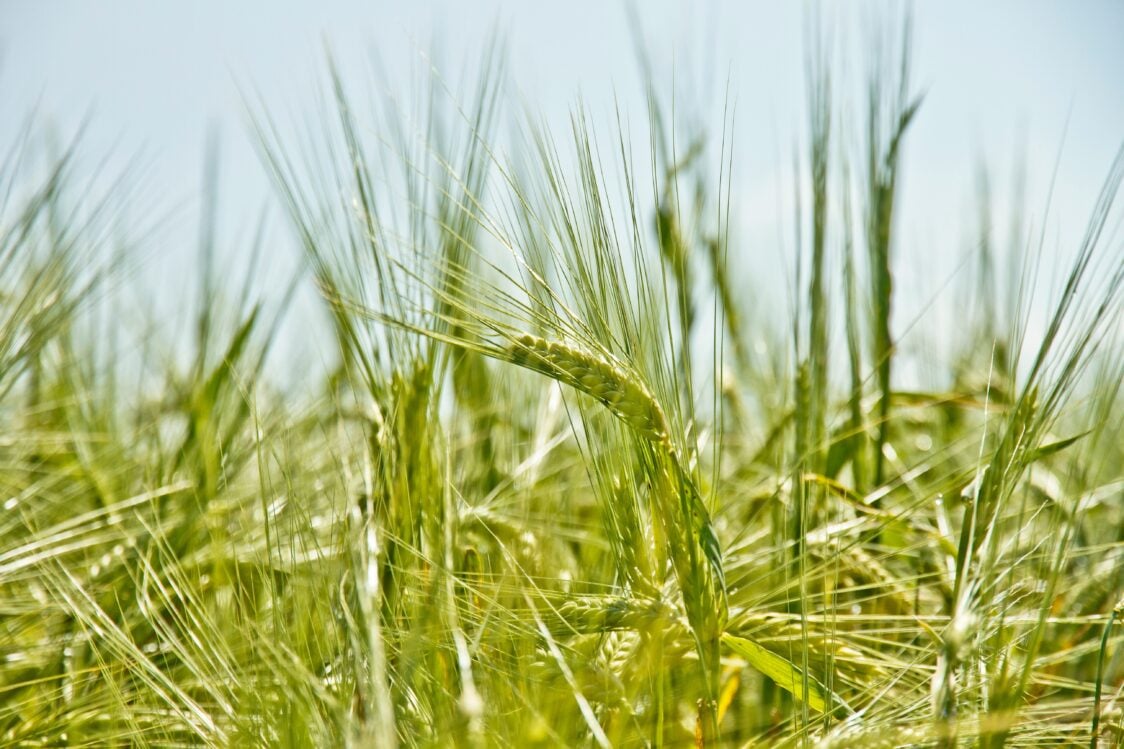
5. Wheatgrass
Wheatgrass (Triticum aestivum) is one of those plants that have a nice green colour due to chlorophyll. That is why it is referred to as green blood by some people. However, it resembles straw in structure. It has played a role for many years, especially in holistic medicine, as it is believed to have many positive effects on health. For those who want to make the most of its potential, it is easiest to ingest it in concentrated powder, tablet or capsule form.
Benefits of wheatgrass
- It is used as part of the supportive treatment of oral cancer.
- It can help fight infection and prevent it from spreading.
- It is associated with a lower risk of developing type 2 diabetes.
- People who have problems with the cardiovascular system may also benefit from its use.[72–74]
What beneficial substances does wheatgrass contain?
Wheatgrass is rich in vitamin C, vitamin E, the beneficial pigment chlorophyll, flavonoids and other antioxidants.[2][75–76]
Average nutritional values of wheatgrass
Values are related to wheatgrass powder.
| Energy value | 248 kcal |
| Carbohydrates | 12.7 g |
| Protein | 18.1 g |
| Fat | 1.3 g |
| Fibre | 52.5 g |
What can you prepare with wheatgrass and how can you incorporate it into your diet?
- smoothie
- porridge
- dough
- drinks
Discover our bestsellers:
Nuts
Nuts are essentially a shelled fruit. They differ in taste, shape and colour. Their great advantage is that they can be eaten both sweet and savoury, so you can easily incorporate them into various recipes. The disadvantage is that nuts are one of the most common allergens, so caution is needed when trying anew type. However, since they have a number of benefits, you should definitely try to include them on a regular basis as much as possible.[77]
In this section, you’ll learn more about these superfoods:
1. Almonds
Almonds (Amygdalus communis) are the seeds of the fruit tree known as the almond tree. There are more than 30 species of almonds, and according to this, almonds differ in their size, taste and content of beneficial substances. One can choose whether to reach for sweet or bitter flavours. Nowadays, they are used in many ways, in addition to the nuts themselves, they can also be eaten in the form of almond milk or gluten-free almond flour.[78–80]
Benefits of almonds
- They can lower both LDL and total cholesterol levels.
- They slow down the absorption of carbohydrates, thus alleviating fluctuations in blood sugar levels.
- Thanks to antioxidants, they can fight oxidative stress and free radicals
- They support cognitive functions such as memory and attention.[81–82]
What beneficial substances do almonds contain?
Almonds are rich in healthy fats such as monounsaturated fatty acids, specifically oleic acid. At the same time, they also contain protein and fibre. Of the micronutrients, they have an interesting proportion of vitamin E, folic acid, magnesium, potassium, calcium and iron. They also contain phytosterols, polyphenols and other biologically active substances.[83–84]
What beneficial substances do almonds contain?
| Energy value | 597 kcal |
| Carbohydrates | 9.5 g |
| Protein | 21 g |
| Fat | 50 g |
| Fibre | 12.5 g |
What can you prepare from almonds and how can you incorporate them into your diet?
- almond biscuits with chocolate
- poppy seed cake with jam and almonds
- coconut protein balls with almonds
- vegan almond slices with fluffy raspberry cream
- vegan almond biscuits with chocolate chips
- Easter cake with honey and almonds
- pumpkin cheesecake muffins with crunchy almonds
- cheesecake with apricots and crunchy almonds
- easy-to-make flourless pizza with mozzarella, almonds and yoghurt

2. Walnuts
Walnuts (Juglans regia) grow on the “royal walnut”. It has a rich history that dates back to 7,000 BC. The whole nut resembles a human head, which is why the ancient Greeks called it karyon (translated as head). This is also reflected on the inside. When the shell is broken, you find a fleshy nut inside that resembles a brain. This makes it clear that they are a superfood for this organ. In addition to the food industry, nuts are also used in cosmetics for the production of natural soaps.[85]
Benefits of walnuts
- They have a positive effect on the cardiovascular system.
- They can help maintain normal cholesterol levels.
- They are beneficial for the brain and nervous system.
- They help to control hunger and increase the feeling of satiety after eating.
- They have anti-inflammatory effects.[86]
What beneficial substances do walnuts contain?
Walnuts are also high in healthy fats, specifically ALA (alpha-linoleic acid), an important omega-3 fatty acid. They are also rich in polyphenols including flavonoids, melatonin and vitamin E.[2][87]
Average nutritional values of walnuts
| Energy value | 686 kcal |
| Carbohydrates | 7 g |
| Protein | 15 g |
| Fat | 65 g |
| Fibre | 6.7 g |
What can you prepare with walnuts and how can you incorporate them into your diet?
- pear galette with walnuts
- pistachio baklava with walnuts
- walnut Parisian rolls with vanilla cream
- Florentine biscuits full of fruit and nuts
- fluffy carrot cake with nuts and vanilla cream
- Christmas tartlet with cinnamon
3. Cashews
Cashews (Anacardium occidentale) come from Brazil, hence the fact that they thrive better in the heat. They grow on a tree that is interesting for its yellow fruits. You may know them as cashew apples. On the end of the fruit itself, you will find a green husk which contains the cashew nut. What is interesting about them is that they should not be eaten raw. They contain the toxic urushiol, which is not suitable for the body and may irritate the skin, for example. Therefore, before the nuts reach the store or your plate, they must be cooked, stewed or roasted before they are shelled. Then they have many benefits for the body.[88–89]
Benefits of cashews
- Thanks to antioxidants, they help fight oxidative stress and free radicals.
- They contribute to the protection of the heart and blood vessels.
- They are beneficial for bone health.
- They have a beneficial effect on immunity.
- They help maintain good eyesight.[90]
What beneficial substances do cashews contain?
Cashews are rich in antioxidants. In addition, they are distinguished by their content of protein, iron, magnesium, selenium, copper, manganese, vitamin B6 and vitamin K.[2][91]
Average nutritional values of cashews
| Energy value | 581 kcal |
| Carbohydrates | 26.7 g |
| Protein | 18 g |
| Fat | 44 g |
| Fibre | 3.3 g |
What can you prepare with cashews and how can you incorporate them into your diet?
- vegan cashew cheese
- quick salad with tuna, cashews and calorie-free sauce
- vegan sundae with homemade cashew yogurt
- vegan spaghetti with cashew sauce
- pasta salad with cashew dressing
- no-bake nut balls with strawberry flavour
- chocolate protein cupcakes
- cinnamon roll flavoured cheesecake
- sweet potato bowl with tofu and cashew dressing
- raspberry raw cake with nuts
- crunchy granola with nuts and quinoa
- oatmeal cake with blueberries
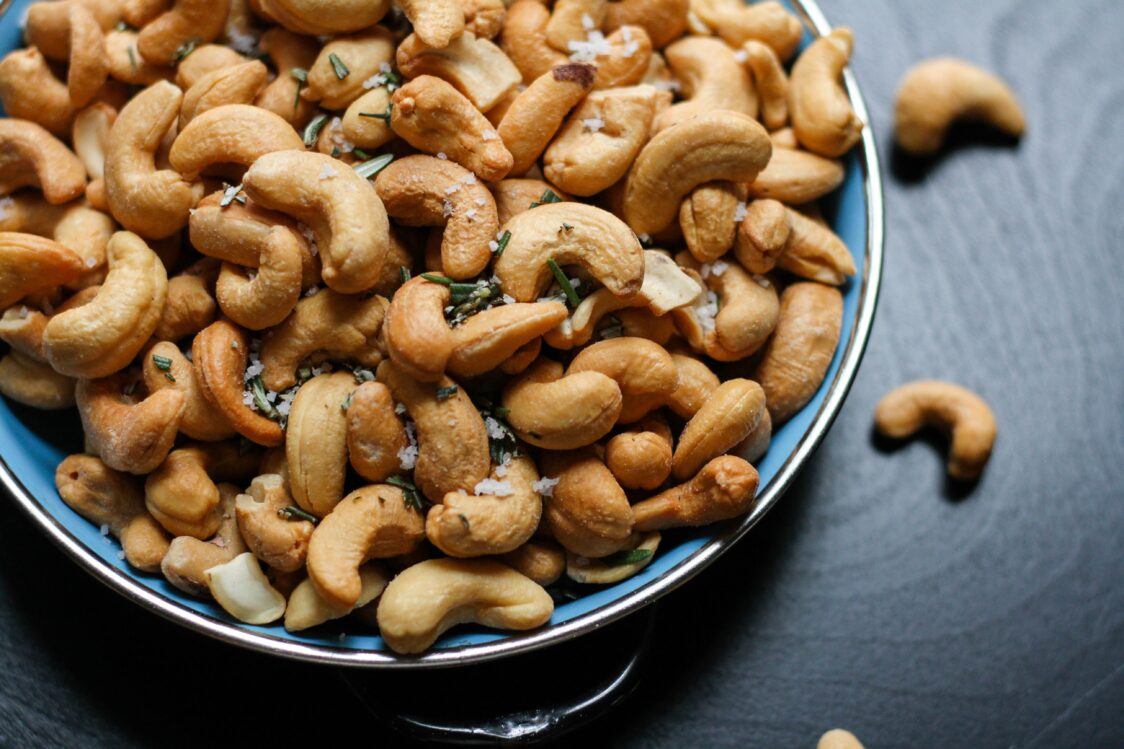
What other nuts are superfoods?
- Peanuts (Arachis hypogaea) have a high protein content, but are also rich in healthy fats such as oleic acid. In addition, they contain calcium, magnesium and potassium. However, they also contain vitamin B3, folic acid and other B vitamins. Among the bioactive substances, you cannot forget the antioxidants, including resveratrol. They are associated with a lower risk of cardiovascular disease, rectal and prostate cancer. They have anti-inflammatory properties and better satiate you.
- Para or Brazil nuts (Bertholletia excelsa) contain healthy fats, selenium, vitamin E, folic acid, magnesium, iodine, potassium and calcium. They have antioxidant properties, anti-inflammatory effects and may help to promote a healthier thyroid gland.
- Pistachios (Pistacia vera) contain essential amino acids in addition to healthy fats and proteins. They are also rich in potassium, magnesium, vitamin E and vitamin B6. They have an effect on optimal blood sugar levels (glycaemia), are beneficial for cardiovascular health, digestion and are associated with a lower incidence of cancer.
- Pecan (Carya illinoinensis) contain monounsaturated fatty acids. They are also rich in manganese, magnesium, potassium, calcium and copper. They are beneficial for cognitive health, can help improve lipid profiles including cholesterol, and have antioxidant properties.
- Hazelnuts (Corylus avellana) contain a good amount of vitamin E, copper, potassium and manganese in addition to monounsaturated fatty acids. They have a positive effect on the lipid profile, and thus on cholesterol. They are beneficial for the cardiovascular system, act as antioxidants, and also excel in their anti-inflammatory properties.
- Macadamia nuts (Macadamia integrifolia) contain healthy fats but also have a good proportion of fibre. They also contain vitamin E, B1, copper, magnesium and manganese. They are beneficial for the cardiovascular system and healthy digestion. [92–102]
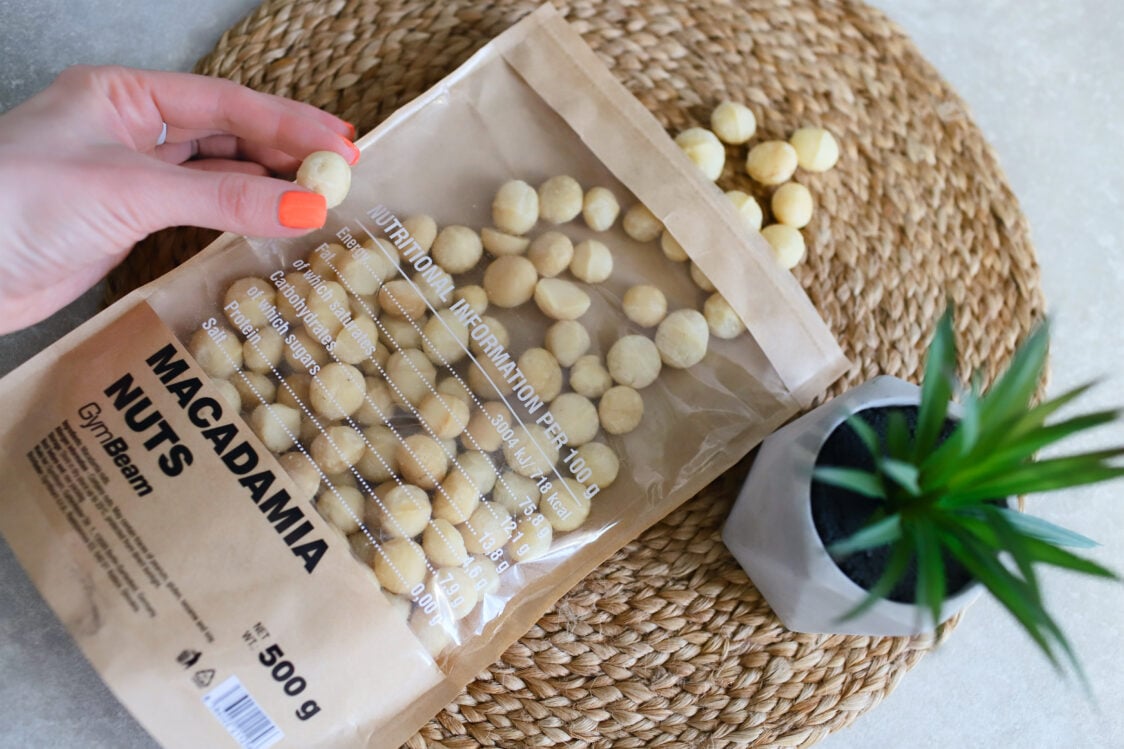
Seeds
Even though seeds are small in size, they compensate for this with a high proportion of beneficial substances. Thanks to this, they can enrich your diet with a number of micronutrients. In addition to these seeds, pumpkin and sunflower seeds or poppy seeds are definitely worth a try.
In this section, you’ll learn more about these superfoods:
1. Cocoa beans
The fact that cocoa beans (Theobroma cacao) are also a superfood will surely please all food lovers. But what does such a bean look like before it reaches your home in the form of chocolate? The fruit of the cocoa tree consists of a pulp and a shell. When you open them, you will find beans inside, which are called cocoa beans. There are approximately 30-50 of them in one fruit. These then undergo fermentation to remove bitterness and other processes. Cocoa is then used to make drinks, chocolates, and other treats.[103]
Benefits of cocoa beans
- They can have a positive effect on the health of the heart and cardiovascular system.
- They will help maintain a more stable blood sugar level.
- They help fight oxidative stress.
- They are also beneficial for your psyche. They reduce stress and promote a feeling of calm and relaxation.
- They promote cognitive performance, which can make it easier for people to think or remember. [104–107]
What beneficial substances do cocoa beans contain?
Cocoa beans are notable for their content of antioxidants such as flavonoids, in particular catechins and procyanidins. Then there are alkaloids, the main representative of which is theobromine. However, they also contain phosphorus, iron, potassium, copper and magnesium. And you will also find vitamins B2, B3 and B6 in them.[2][108]
Average nutritional values of cocoa beans
| Energy value | 551 kcal |
| Carbohydrates | 5.2 g |
| Protein | 15 g |
| Fat | 47 g |
| Fibre | 23 g |
What can you prepare from cocoa beans and how can you incorporate them into your diet?
- soft banana brownies with peanut butter and cocoa
- chocolate smoothies
- vegan banana bread with protein and nut butter
2. Chia seeds
Chia seeds (Salvia hispanica) are obtained from a plant known as Hispanic sage, which is native to Mexico and Guatemala. These are small black balls that have been used for several thousands of years. The ancient Aztecs held them in high esteem. They ate them before longer performances, such as running, but they also used them as currency.[109]
Benefits of chia seeds
- Thanks to their omega-3 content, they can support heart health and the cardiovascular system.
- They are beneficial for both brain and eye health.
- They promote healthy bone mineralisation.
- They fight oxidative stress and free radicals.
- They are beneficial during weight loss.
- They have a positive effect on immunity. [110–112]
What beneficial substances do chia seeds contain?
Chia seeds are a great source of protein with a favourable amino acid spectrum, but they also contain fibre, healthy fats and antioxidants such as polyphenols, quercetin and chlorogenic acid. However, you must not forget their content of calcium, magnesium, potassium, selenium, folic acid and vitamin E.[2][113]
Average nutritional values of chia seeds
| Energy value | 486 kcal |
| Carbohydrates | 42 g |
| Protein | 16.5 g |
| Fat | 30.7 g |
| Fibre | 34.4 g |
What can you prepare from chia seeds and how can you incorporate them into your diet?
- quark chia pudding with fruit
- coconut chia pudding with banana
- homemade strawberry jam with chia seeds
- chia tiramisu pudding
- quick banana chia pudding with almond milk
- vegan protein biscuits with chia seeds
- for vegan recipes, chia gel (swollen seeds with water) acts as a great egg substitute.
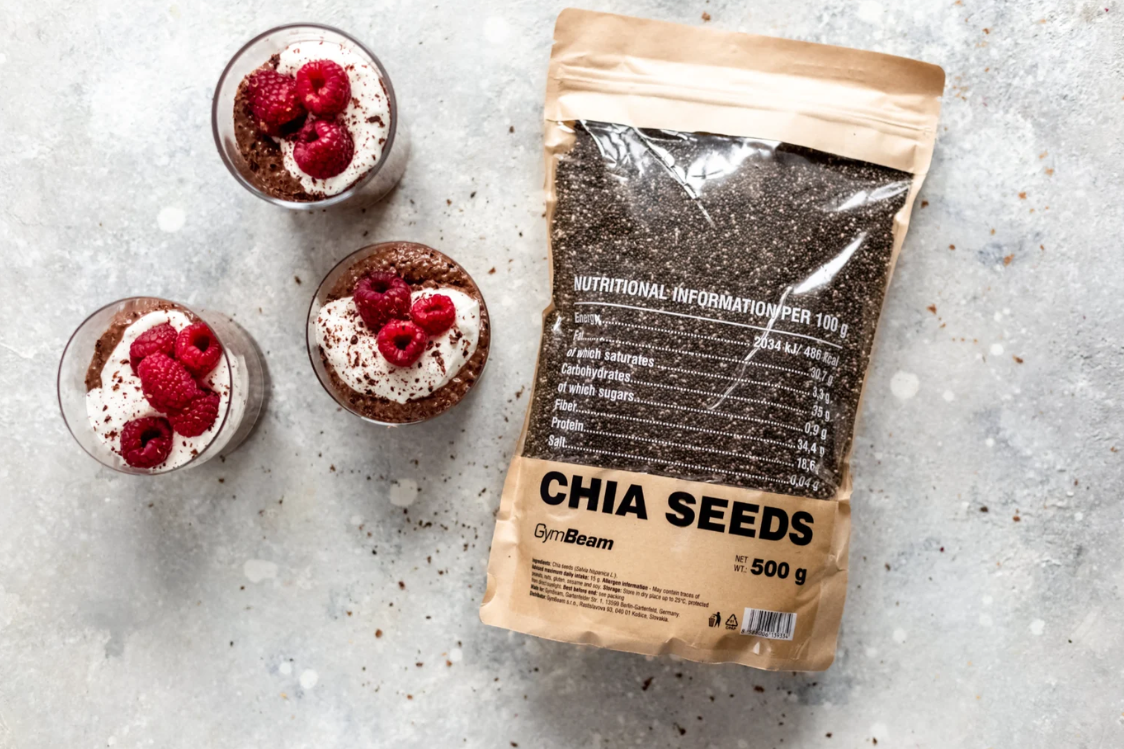
3. Hemp seeds
As the name suggests, hemp seeds (Cannabis sativa) come from the hemp plant. However, they contain almost no psychotropic substances, so there is no need to worry about their effects in this respect. Therefore, you can incorporate them into your diet with a clear conscience and enjoy the benefits of this plant.
Benefits of hemp seeds
- They can help lower cholesterol in people who suffer from high cholesterol levels.
- They help with the care of the cardiovascular system.
- They can help relieve dryness or itching of the skin associated with eczema. [114–115]
What beneficial substances do hemp seeds contain?
Although it would be nice if hemp seeds were also a source of CBD cannabidiol with a wide range of effects, this is not the case. Therefore, you have to make do with flavonoids, proanthocyanidins, phenolic acid, amino acids, healthy fats and vitamin K. However, phosphorus, potassium, magnesium, calcium, zinc, iron and vitamins A, D and E are not lacking either. [2][116]
Average nutritional values of hemp seeds
| Energy value | 553 kcal |
| Carbohydrates | 8.67 g |
| Protein | 31.6 g |
| Fat | 48.8 g |
| Fibre | 4 g |
What can you prepare with hemp seeds and how can you incorporate them into your diet?
4. Flax seeds
There is no doubt about the benefits of flax seeds (Linum usitatissimum). Their Latin name means “very useful”. It is a crop that has been cultivated around the world since the beginning of civilization. It was primarily used in clothing and stationery, while flaxseed oil and seeds were primarily used as animal feed. Only over time did it become clear how much you can benefit from it. [117]
Benefits of flax seeds
- They can help lower blood sugar levels.
- They are associated with a lower risk of developing breast cancer.
- They have a positive impact on digestion.
- They support the health of the cardiovascular system.[118]
What beneficial substances do flax seeds contain?
In addition to the beneficial omega-3 fatty acids and fibre, flaxseeds are also rich in copper, phosphorus, magnesium, manganese, vitamin B1 and B6. [2][119]
Average nutritional values of flax seeds
| Energy value | 534 kcal |
| Carbohydrates | 29 g |
| Protein | 19.3 g |
| Fat | 42 g |
| Fibre | 27 g |
What can you prepare from flax seeds and how can you incorporate them into your diet?
- crispy seed crackers
- crunchy bread packed with fibre and protein
- no-bake brownies
- autumn apple pie with pecan crumble
- pumpkin cake with pecan nuts
- soft carrot cake packed with protein
- cauliflower and broccoli pancakes
- cheesecake from a blender
- just like chia seeds they can help replace eggs in dough
5. Sesame seeds
Sesame seeds (Sesamum indicum) come from a plant with white bell-shaped flowers called Indian sesame. The seeds can have several colours, most often you can find white, black, brown or red sesame. In addition, they all differ in their taste. They have been used for their benefits in Chinese medicine for years. Nowadays, the seeds are most often sprinkled directly onto dishes, but you can also enjoy sesame oil or tahini paste, which is prepared by grinding the seeds.[120–121]
Benefits of sesame seeds
- Thanks to their antioxidant content, they help fight free radicals.
- They are beneficial for digestion.
- They can help lower cholesterol levels.
- Thanks to their magnesium content, they can help lower blood pressure.
- They have a positive effect on bone health.
- They can support thyroid health.
- They may have anti-inflammatory effects. [122–124][236]
What beneficial substances do sesame seeds contain?
Sesame seeds are rich in iron, copper, magnesium, phosphorus and vitamins B1, B3 and B6. In addition, they also contain antioxidants. [2]
Average nutritional values of sesame seeds
| Energy value | 573 kcal |
| Cabohydrates | 23.4 g |
| Protein | 17.7 g |
| Fat | 49.7 g |
| Fibre | 11.8 g |
What can you prepare from sesame seeds and how can you incorporate them into your diet?
- falafel with homemade hummus
- chickpea hummus 3× variations
- seitan noodles with broccoli in Asian sauce
- protein granola bars
- vegan stir-fry with tofu and vegetables
- crunchy bread packed with fibre and protein
- soba noodles with tofu and vegetables
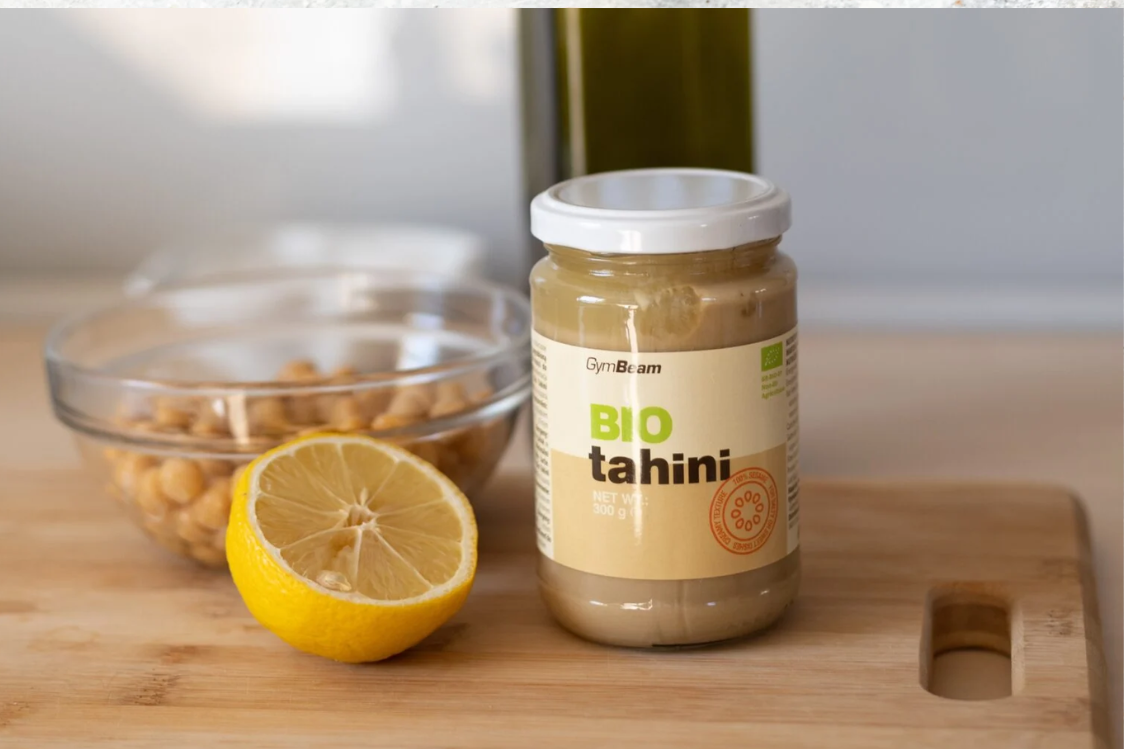
Roots
Beneficial roots have been used for thousands of years. However, their popularity is continually growing today. All the more so because you can use them in many forms. Thanks to its concentrated powder form,it gives you the unique opportunity to taste new varieties.
In this section, you’ll learn more about these superfoods:
1. Turmeric
Turmeric (Curcuma longa) has been used around the world for thousands of years, for example as an important element in Hindu and Buddhist religious ceremonies. In addition, monks were forbidden to wear white clothes, so they dyed their clothes with turmeric. Due to its excellent availability, it is nicknamed Indian saffron. At a time when saffron was expensive and relatively scarce, turmeric was used as a substitute. Today, it is becoming more and more popular, so it is not uncommon to find turmeric lattes in cafes, for example.[125]
Benefits of turmeric
- Thanks to its anti-inflammatory effects, it can help with arthritis.
- It can reduce the symptoms of anxiety and depression to some extent.
- It is associated with a lower likelihood of developing neurodegenerative diseases.
- It is used as a supportive aid in the treatment of cardiovascular diseases.
- Has a positive effect on brain health.
- It is associated with a lower risk of developing cancer. [126–129]
What beneficial substances does turmeric contain?
Turmeric is also known for its high content of antioxidants such as polyphenols. The most famous is curcumin, to which it owes many of its abilities. It is certainly not lacking in vitamin C, vitamin B6, manganese, iron or potassium.[2]
Nutritional values of turmeric
The values given refer to 100 g of turmeric in powder form.
| Energy value | 395 kcal |
| Carbohydrates | 53.6 g |
| Protein | 10 g |
| Fat | 11.5 g |
| Fibre | 13 g |
What can you prepare with turmeric and how can you incorporate it into your diet?
- chicken mix with turmeric and coconut milk
- Indian butter chicken
- fragrant Indian curry with chopped chicken meat
- hummus
- creamy lentil soup
- vegan curry with tofu and chickpeas
- chickpea curry soup with coconut milk and quinoa
- add to a ginger shot to increase the proportion of beneficial substances
- turmeric latte
2. Ginger
Ginger (Zingiber officinale) is a food with many benefits, which has its tradition mainly in Japan. There, it is used primarily between courses to cleanse the palate and prepare for new flavours. Most often it is used in the form of tea when you want to warm up or when you are sick. It is also used to flavour food. The oil from this root is also used as an ingredient in perfumes.[130]
Benefits of ginger
- It can help reduce pain related to osteoarthritis.
- It can lower blood pressure.
- It can help reduce menstrual pain.
- It has anti-inflammatory properties.
- It can be effective during weight loss.
- It helps reduce nausea, even during pregnancy or during chemotherapy.
- Supports immunity.
- It is beneficial for cardiovascular health.
- Helps fight oxidative stress. [131–139]
What beneficial substances does ginger contain?
Ginger is rich in antioxidants, especially gingerol. In addition, it also contains vitamin B6, iron, potassium, vitamin C, magnesium, phosphorus, zinc, folic acid and vitamin B3. [2]
Nutritional values of ginger
| Energy value | 81 kcal |
| Carbohydrates | 15.8 g |
| Protein | 1.82 g |
| Fat | 0.75 g |
| Fibre | 2 g |
What can you prepare with ginger and how can you incorporate it into your diet?
- Pad Thai with chicken and ginger
- smoothie
- delicious ramen full of protein and flavour
- Teriyaki chicken
- Indian butter chicken
- juicy chicken breast in orange sauce
- autumn cakes
- shots
- ginger tea

3. Ashwagandha
Ashwagandha (Withania somnifera) is an herb that has been used in Ayurveda and Chinese medicine for thousands of years. You may also know it as Indian ginseng or Indian winter cherry. It is a small shrub with yellow flowers, grown mainly in India and North Africa. It is considered to be an “adaptogen” with many beneficial benefits, which is why it is becoming increasingly popular worldwide.
Benefits of ashwagandha
- It can help you better manage stressful situations.
- Helps to better manage anxiety.
- It has a positive effect on cognitive functions. It can improve memory, concentration, psychological well-being and sleep.
- It can have a positive effect on testosterone levels and on the overall reproductive health of both men and women.
- Supports immunity.
- Improves cardiovascular performance and regeneration in healthy athletes.[140–144]
What beneficial substances does ashwagandha contain?
The main functional substances of ashwagandha, thanks to which this plant has so many beneficial effects, are alkaloids (isopelletierine, anaferine, kuseohygrin, anahygrin, etc.), saponins and steroid lactones (withanolides, withaferines). It is withanolides that are considered to be the main biologically active substance of this powerful adaptogen.[145]
Nutritional values of ashwagandha
The values given refer to 100 g of ashwagandha in powder form.
| Energy value | 350 kcal |
| Carbohydrates | 80 g |
| Protein | 4.9 g |
| Fat | 1 g |
What can you prepare with ashwagandha and how can you incorporate it into your diet?
- in powder form, it can be added to smoothies, porridges and desserts
4. Maca
Maca (Lepidium meyenii) alias Peruvian ginseng or Peruvian maca is a plant that is native to the Andes and grows only at high altitudes. It can be of different colours – from yellow to red, purple to black. You will reap the most benefits from it if you use it raw, in the form of powder, tablets or capsules. It belongs among the adaptogens and thus has undeniable positive effects on your body.[146]
Benefits of maca
- It has a positive effect on libido and, according to research, could act as an aid in the case of erectile dysfunction. As a result, it is used in an effort to improve sex life.
- It can improve the quality, quantity and motility of sperm.
- Supports endurance performance.
- It can reduce the symptoms of depression in menopausal women.
- It can lower blood pressure in cases of hypertension.
- Helps fight free radicals and oxidative stress. [147–152]
What beneficial substances does maca contain?
Maca contains a number of beneficial essential amino acids. It does not lack fibre, iron, iodine, potassium, copper, manganese, vitamin C, B2, B3 and B6 either. However, we must also mention polyphenols, macaenes (unsaturated fatty acids typical of maca), alkaloids (e.g. macamides), glucosinolates, phytosterols and tannins.[2][153–154][237–240]
Nutritional values of maca
The values given refer to 100 g of maca powder.
| Energy value | 320 kcal |
| Carbohydrates | 72 g |
| Protein | 11.3 g |
| Fat | 0.7 g |
| Fibre | 16 g |
What can you prepare with maca and how can you incorporate it into your diet?
- in powder form, it can be added to smoothies, porridges and desserts
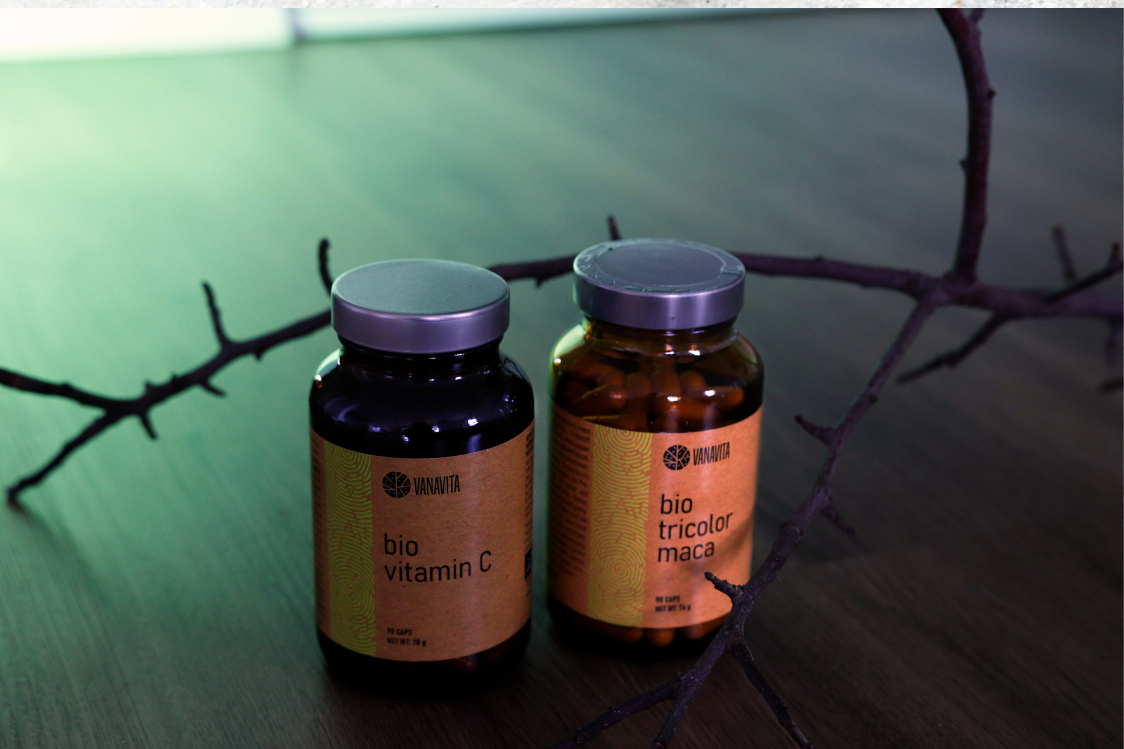
Mushrooms
Although it is common to have mushrooms in your diet, some may not be readily available in raw form. Therefore, you can also resort to using the form of capsule or tablet supplements. This is also why we deliberately exclude nutritional values for this category. However, we will certainly not deprive you of information regarding their benefits.
In this section, you’ll learn more about these superfoods:
1. Cordyceps
Cordyceps (Ophiocordyceps sinensis) alias Chinese caterpillar has previously been referred to as a treasure. As the name suggests, its shape resembles a caterpillar and it is known to parasitise insect larvae. Although there are more than 400 species of Cordyceps, research has focused mainly on the health effects of Cordyceps sinensis and Cordyceps militaris, which are among the most widely used. [155–156]
Benefits of cordyceps
- It may have anti-inflammatory and analgesic effects due to its cordycepin content.
- It has a positive effect on performance and physical well-being.
- It is used as a supportive aid in the treatment of cancer.
- It can help reduce oxidative stress.
- It is used as part of an anti-ageing routine to slow down the signs of ageing.
- Is beneficial for heart health.
- It has a positive effect on your immunity. [157–161]
What beneficial substances do cordyceps contain?
Cordyceps is known for its content of nucleosides, polysaccharides, sterols, proteins, amino acids and polypeptides. Other bioactive substances include cordycepin, ergosterol, mannitol and adenosine. Thanks to this, it boasts many positive effects on the human body.[162]
2. Reishi
Reishi (Ganoderma lucidum) is a mushroom native to Asia, which you may also know under the name Glossy Ganoderma. It is a dark mushroom with a woody texture that has a shiny surface. In Chinese, its name is associated with spiritual power, immortality, success, well-being and longevity. Previously, this mushroom was difficult to find, but nowadays it is commonly available in powder or tablet form.[163–165]
Benefits of reishi
- It can help stabilise blood sugar levels (glycaemia).
- Supports the body’s defences.
- Studies also mention its chemo preventive or tumoricidal (tumour-killing) abilities.
- May help reduce symptoms of neurasthenia (neural weakness).[166–169]
What beneficial substances do Reishi contain?
Reishi is known for its content of bioactive substances such as terpenoids, steroids, phenols and nucleotides. Another great advantage is its protein content, including the essential amino acids lysine and leucine. The three main physiologically active components in reishi are polysaccharides, peptidoglycans and triterpenes. [170–173]
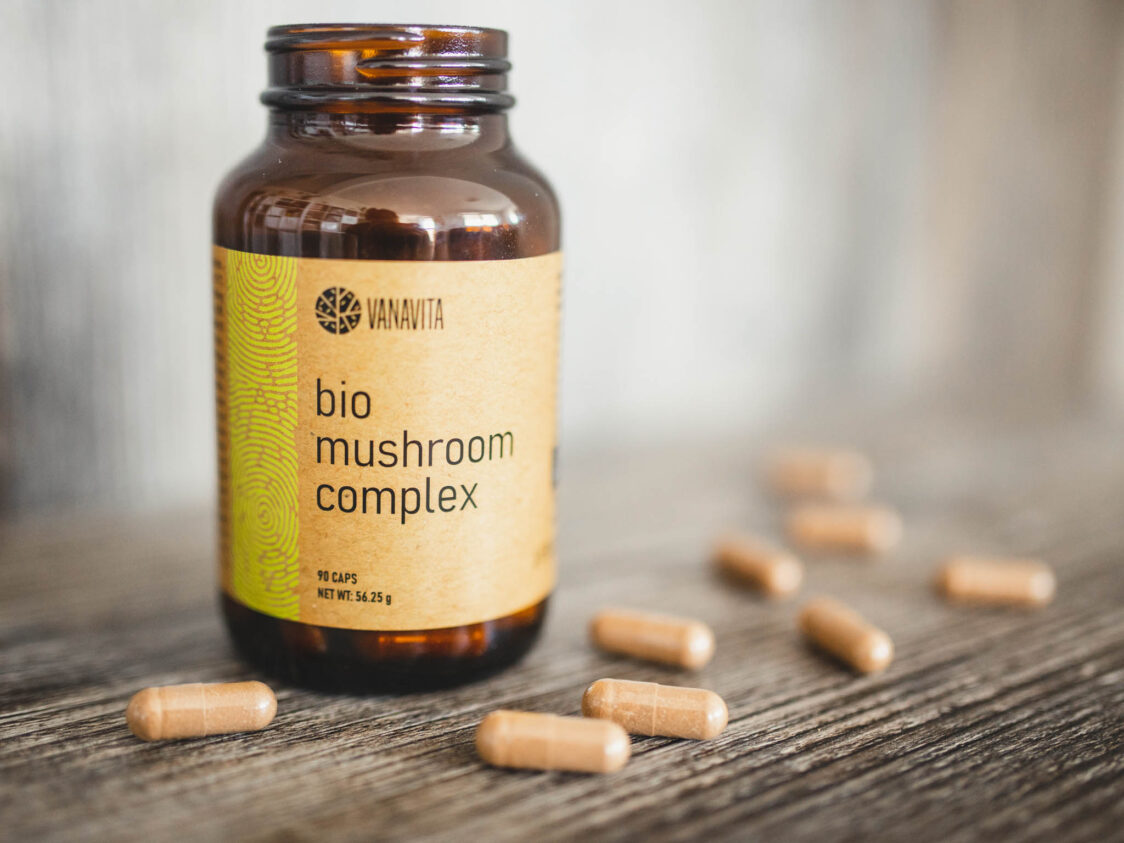
3. Chaga
The mushroom chaga (Inonotus obliquus) may also be known as andslanted rust. It is a wood-destroying fungus that grows on birch trees and resembles a pile of dirt. However, it differs from the latter by its orange part. Chaga grows under the bark of the tree, which gradually falls off due to this. It is found in northern Europe, Russia or Asia. The easiest way to reap its benefits is to use concentrated supplements such as a powder form.
Benefits of chaga
- It is associated with lower values of “bad” cholesterol.
- In studies, a slowing down of the growth of cancer cells or tumours has been observed.
- It is associated with anti-inflammatory effects.
- It has a positive effect on the immune system.[174–176]
What beneficial substances does chaga contain?
Chaga contains polyphenols, triterpenoids and polysaccharides. But it also boasts a good proportion of antioxidants, which have a positive effect on the body.[177]
4. Hericium
Hericium erinaceus is an edible mushroom also known as lion’s mane. It is white in colour and divided into many hanging strands. It grows in coniferous forests in northern climates such as Canada, Russia and northern Europe. Nowadays it is popular mainly due to its nootropic properties.[178–180]
Benefits of hericium
- It can have a positive effect on cognitive functions such as memory or attention, and is even considered a nootropic.
- It has a positive effect on the psyche. In menopausal women, it helps reduce the symptoms of depression and anxiety.
- Studies have also described its use as adjuvant therapy in the treatment of leukaemia.
- It can have a positive effect on heart health, control sugar levels, support the digestive tract and wound healing.[181–188]
What beneficial substances does hericium contain?
Hericium is known for its content of beta-glucan polysaccharides. Other beneficial substances contained in hericium include erinacins and hericenones, which are associated with neuroprotective effects. Lion’s Mane also boasts a wide range of antioxidants.[189–190]
5. Shiitake
Shiitake (Lentinula edodes) is one of the most popular mushrooms worldwide, regularly appearing in many people’s diets. You may also know it as “Lentinula mushroom”, but it is also referred to as the elixir of life. It has a brown hat with a typical diameter of 5–10 cm. However, lighter irregular sections may also appear on its surface. Shiitake is distinguished by its meatiness and rich flavour, which has made it part of the Asian diet for hundreds of years.[191]
Benefits of shiitake
- It can have a positive effect on cholesterol levels.
- It can support the proper function of immunity.
- In studies, it is also known for its anti-cancer properties.
- It can boost the immune system.[192–195]
What beneficial substances does shiitake contain?
Shiitake is high in fibre. Among the active substances it is necessary to mention terpenoids, sterols and lipids, which have many positive effects. The quantity present depends on the length of cultivation, storage and preparation. However, it also has a high content of vitamins and minerals. For example, we can name vitamins B5, B2, B3, B6 and vitamin B9. However, their composition also includes copper, selenium, magnesium and zinc. And, of course, bioactive substances such as sterols, eritadenine and the like. [196–198]
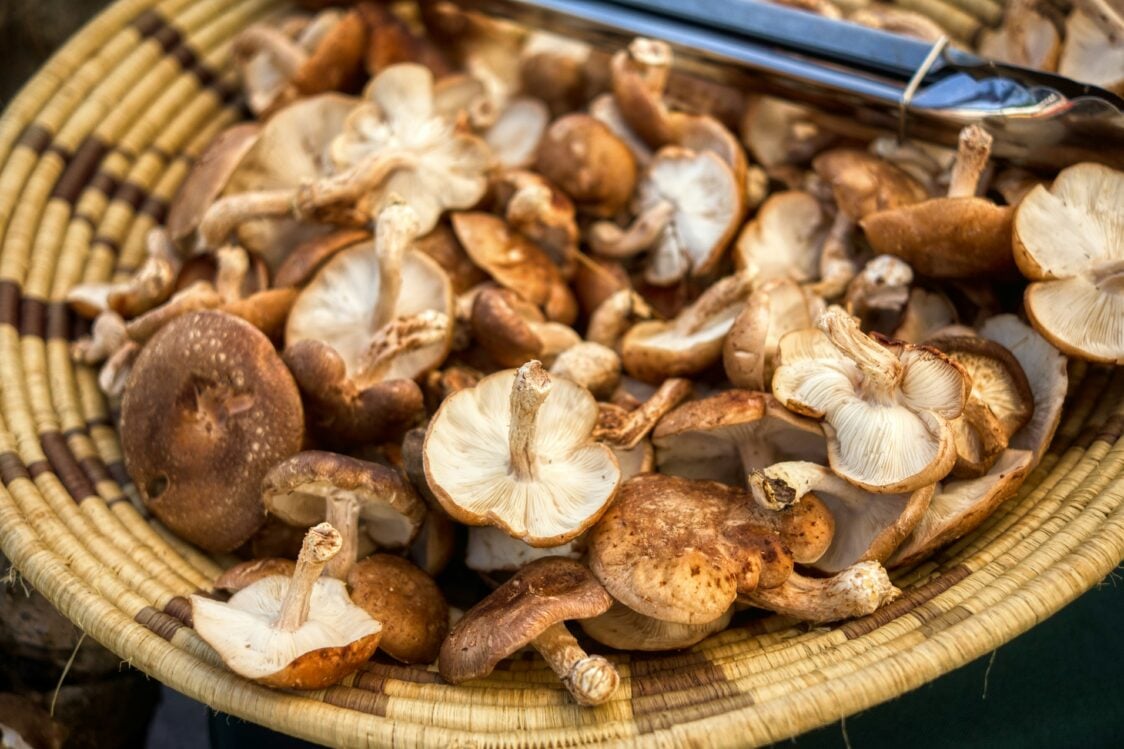
6. Maitake
Maitake (Grifola frondosa) is a polypore mushroom, which you may also know under the name of hen-of-the-woods mushroom, but it is also known as the dancing mushroom. This name is said to have originated when Buddhist nuns searched for food and accidentally discovered this mushroom. Due to the fact that it was a great delicacy, they celebrated the find by dancing. Its fruit looks like a large cluster, you can see it on tree stumps. It is considered an adaptogen, which is why people across the globe like to include it in their diets.[199–201]
Benefits of maitake
- It is used to increase the body‘s resistance to stress and other external influences.
- Studies show that it can be used as a supportive supplement in cancer treatment as it can help reduce the development of cancer cells. [202–204]
What beneficial substances does maitake contain?
The main bioactive substances are beta-glucans. However, there are also various polysaccharide fractions. Of course, there is also a decent amount of amino acids. In addition, maitake boasts a high content of vitamin B3. [205–206]
7. Oyster mushrooms
Oyster mushrooms (Pleurotus ostreatus) are a popular, readily available mushroom. It can be recognised by its white to light brown funnel-shaped fruit, which is approximately 5-25 cm in diameter. Another characteristic feature is the short leg and also the occurrence in clusters. It has a delicate flavour and velvety texture, for which it is very popular in cooking. [207]
Benefits of oyster mushrooms
- It helps the body cope with oxidative stress.
- It can help reduce the level of “bad” cholesterol in the blood.
- It can also help improve blood pressure and blood glucose levels in patients with diabetes.
- Supports immunity.
- Helps reduce fatigue and exhaustion.
- Contributes to the protection of cells from oxidative stress. [208–213]
What beneficial substances do oyster mushrooms contain?
They contain many bioactive substances such as polysaccharides, peptides, proteins, terpenoids, fatty acid esters and polyphenols. In addition, they are a great source of vitamin B3 and vitamin B2. You will also find important antioxidants in oyster mushrooms.[2]
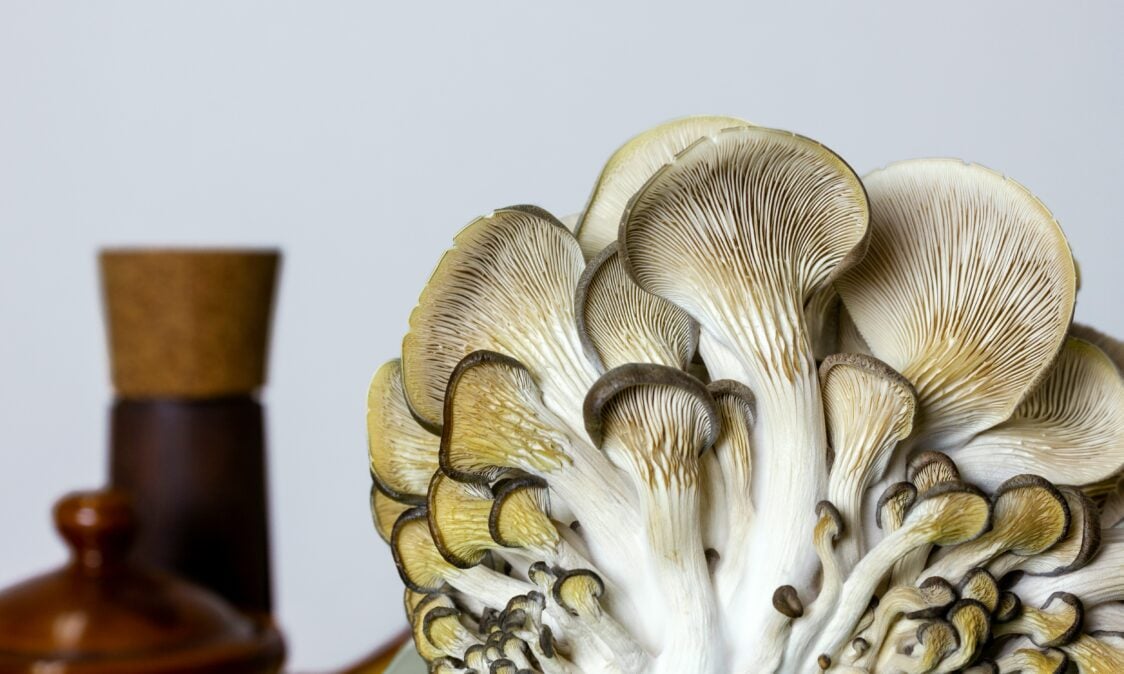
What other mushrooms are superfoods?
- Turkey tail (Trametes versicolor) contains leucine, isoleucine, methionine, tyrosine, glutamine and asparagine. It also contains vitamin B3 (niacin) and fatty acids. It works to support immunity, as part of the prevention of breast cancer, but it is also a prebiotic.
- White fungus or snow fungus (Tremella fuciformis) boasts polysaccharides, proteins, fibre, vitamins, antioxidants and minerals. It helps to reduce oxidative stress, has a neuroprotective function and works as a supplement for people fighting cancer. In addition, it is referred to as the longevity mushroom.[214–226]
What other superfoods are out there?
- Psyllium is classified as a soluble fibre, but its properties partly resemble those of insoluble fibre. It has a positive effect on digestion, helps lower cholesterol, has an effect on blood sugar levels, which can help diabetics, and last but not least, it is great for weight loss. It helps to maintain a feeling of satiety. [227–230]
- Guarana is known for containing more caffeine than coffee beans. In addition, it also contains catechins and procyanidins. It is popular mainly for its stimulating effects. However, it is also used in the care of immunity and digestion. [232] [213]
- Fermented dairy products are dairy products that have undergone fermentation, during which lactose is split, making the finished products more digestible. In addition, they contain a higher number of healthy bacteria, which is appreciated by your entire digestive system. [233]
- Quinoa is a gluten-free pseudocereal containing iron, magnesium, potassium, zinc, copper and selenium. However, it also contains vitamins B1, B2, B6 and B9. It is a great source of protein. It can also help during weight loss, but it is also good for maintaining blood sugar and cholesterol levels and is beneficial for digestion. In addition, it helps fight oxidative stress. Our separate article will tell reveal more about it.
- Buckwheat contains potassium, phosphorus, magnesium, calcium and iron. It also does not lack in vitamin B2, B3, folic acid, vitamin K and B6.Supports heart health and digestion.
- Amaranth contains iron, magnesium, copper, vitamin B6 and folic acid. It can help lower cholesterol levels and has an effect on cardiovascular health. [234]
- Honey contains vitamins, minerals, phenols, organic compounds, carotenoids, enzymes and other bioactive substances. It can be useful as a wound healing aid, and can also relieve symptoms of stomach ulcers or indigestion. It is also used for sore throats and coughs. Manuka Honey from New Zealand is a great choice.[231]
However, there are many other foods that are high in beneficial substances and can be considered superfoods. This certainly does not mean that you have to stick to this list alone. Therefore, try to maintain a varied diet so that you can get the most out of each food and its beneficial substances.
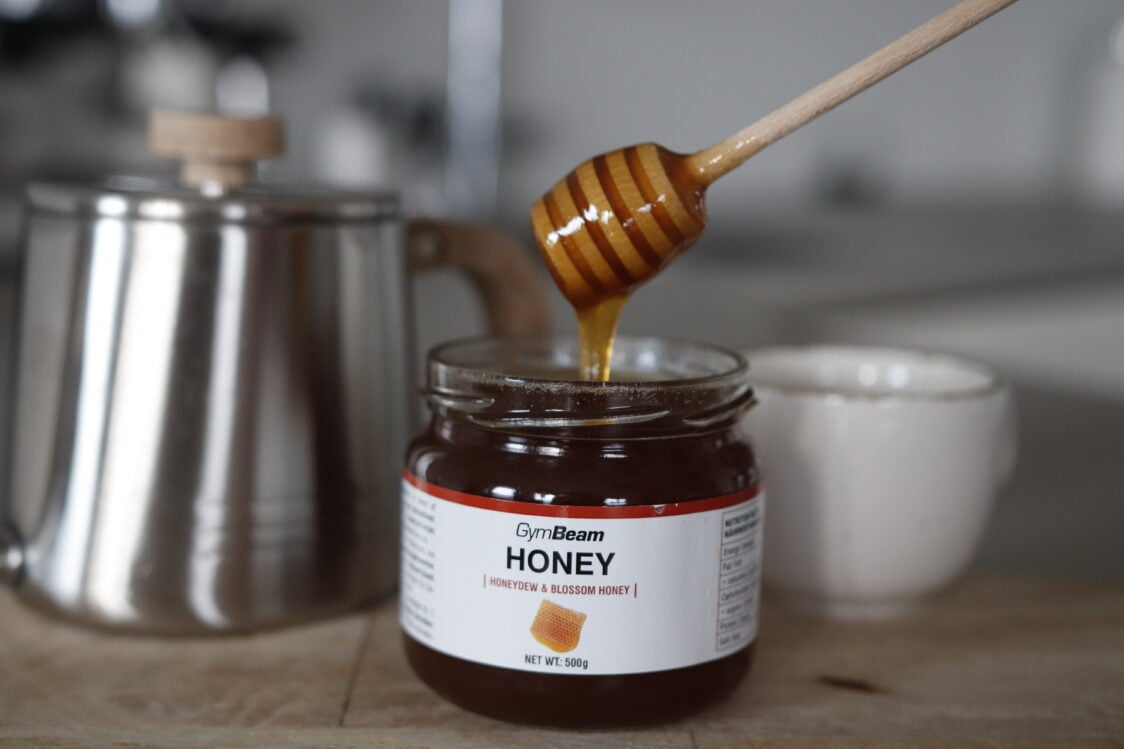
How can you add more superfoods to your diet?
- Whole foods like fruit and vegetables should be part of every meal. You don’t just have to eat them in salads, many of them can be incorporated into dough for desserts without anyone even knowing.
- From mushrooms, you can prepare great soups, sauces and side dishes. If you do not like them, you can still reap their benefits through tablets, capsules or a powder form.
- Nuts are another food that go well in many dishes and add some crunchiness. They are also suitable as a snack on their own.
- And again, roots such as ginger or maca are available in many forms. They can be added to sauces, smoothies, porridge, desserts and other dishes. Similarly, other superfoods are available in many forms.
What should you remember?
As you can see, superfoods are not just green pills that may not be very appealing at first glance. Thanks to this article, you may have even realised how many superfoods you have at home and routinely include in your diet. The main thing to emphasise here is a varied diet, so that you obtain all the macronutrients you need. If you add some superfoods to every meal, you will readily reap their benefits. This will support your health and overall vitality and make you feel good. Moreover, in this way, you can easily help the body to overcome or develop many diseases.
[1] Superfoods or Superhype? – https://www.hsph.harvard.edu/nutritionsource/superfoods/
[2] U.S. DEPARTMENT OF AGRICULTURE, food data central – https://fdc.nal.usda.gov/
[3] FUN FACTS YOU DIDN'T KNOW ABOUT GOJI BERRIES – https://ayoubs.ca/blogs/news/facts-that-you-didnt-know-about-goji-berries
[4] Harunobu Amagase, Bixuang Sun, Dwight M Nance – Immunomodulatory effects of a standardized Lycium barbarum fruit juice in Chinese older healthy human subjects – https://pubmed.ncbi.nlm.nih.gov/19857084/
[5] Peter Bucheli et al. – Goji berry effects on macular characteristics and plasma antioxidant levels – https://pubmed.ncbi.nlm.nih.gov/21169874/
[6] Shang Li et al. – Macular pigment and serum zeaxanthin levels with Goji berry supplement in early age-related macular degeneration – https://www.ncbi.nlm.nih.gov/pmc/articles/PMC6010398/
[7] Joan E. Roberts, Jessica Dennison – The Photobiology of Lutein and Zeaxanthin in the Eye – https://www.ncbi.nlm.nih.gov/pmc/articles/PMC4698938/
[8] Harunobu Amagase and Dwight M. Nance – A Randomized, Double-Blind, Placebo-Controlled, Clinical Study of the General Effects of a Standardized Lycium barbarum (Goji) Juice, GoChi™ – https://www.liebertpub.com/doi/abs/10.1089/acm.2008.0004
[9] Did You Know? 10 Surprising Facts About Blueberries – https://www.bcblueberry.com/bc-blueberry-council/news/did-you-know-10-surprising-facts-about-blueberries
[10] Peter J Curtis et al. – Blueberry anthocyanin intake attenuates the postprandial cardiometabolic effect of an energy-dense food challenge: Results from a double blind, randomized controlled trial in metabolic syndrome participants – https://pubmed.ncbi.nlm.nih.gov/34883305/
[11] Ximena Palma et al. – Acute Consumption of Blueberries and Short-Term Blueberry Supplementation Improve Glucose Management and Insulin Levels in Sedentary Subjects – https://pubmed.ncbi.nlm.nih.gov/33922965/
[12] Anand R. Nair et al. – Blueberry supplementation attenuates oxidative stress within monocytes and modulates immune cell levels in adults with metabolic syndrome: a randomized, double-blind, placebo-controlled trial – https://pubs.rsc.org/en/content/articlelanding/2017/fo/c7fo00815e/unauth
[13] Basharat Yousuf et al. – Health Benefits of Anthocyanins and Their Encapsulation for Potential Use in Food Systems: A Review – https://www.tandfonline.com/doi/full/10.1080/10408398.2013.805316
[14] Elizabeth E. Devore ScD et al. – Dietary intakes of berries and flavonoids in relation to cognitive decline – https://onlinelibrary.wiley.com/doi/10.1002/ana.23594
[15] Blueberry – https://examine.com/foods/blueberry/
[16] 10 Fun Facts About Strawberries You Never Knew – https://www.ediblearrangements.com/blog/fun-facts-about-strawberries/
[17] Jace Schell et al. – Strawberries Improve Pain and Inflammation in Obese Adults with Radiographic Evidence of Knee Osteoarthritis – https://www.mdpi.com/2072-6643/9/9/949
[18] Sadia Afrin† et al. – Promising Health Benefits of the Strawberry: A Focus on Clinical Studies – https://pubs.acs.org/doi/10.1021/acs.jafc.6b00857
[19] Aleksandra S. Kristo et al. – Protective Role of Dietary Berries in Cancer – https://www.ncbi.nlm.nih.gov/pmc/articles/PMC5187535/
[20] 21 Fun Facts About Raspberries – https://www.funfactsabout.com/facts-about-raspberries/
[21] European Raspberry – https://examine.com/supplements/european-raspberry/
[22] Arpita Basu et al. – Dietary fruits and arthritis – https://pubs.rsc.org/en/content/articlelanding/2018/FO/C7FO01435J
[23] Pei-Wen Wang et al. – Red Raspberry Extract Protects the Skin against UVB-Induced Damage with Antioxidative and Anti-inflammatory Properties – https://www.hindawi.com/journals/omcl/2019/9529676/
[24] Hércules Rezende Freitas et al. – Fatty Acids, Antioxidants and Physical Activity in Brain Aging – https://www.ncbi.nlm.nih.gov/pmc/articles/PMC5707735/
[25] Health benefits of raspberries – https://www.medicalnewstoday.com/articles/283018
[26] Maneli Mozaffarieh et al. – The role of the carotenoids, lutein and zeaxanthin, in protecting against age-related macular degeneration: A review based on controversial evidence – https://nutritionj.biomedcentral.com/articles/10.1186/1475-2891-2-20
[27] European Raspberry – https://examine.com/supplements/european-raspberry/
[28] What are the health benefits of acai berries? – https://www.medicalnewstoday.com/articles/305576
[29] Acai – https://www.nccih.nih.gov/health/acai
[30] Manoela Maciel dos Santos Dias et al. – Pro-apoptotic activities of polyphenolics from açai (Euterpe oleracea Martius) in human SW-480 colon cancer cells – https://pubmed.ncbi.nlm.nih.gov/25329001/
[31] Acai – Uses, Side Effects, and More – https://www.webmd.com/vitamins/ai/ingredientmono-1109/acai
[32] Health Benefits of Physalis – https://www.webmd.com/diet/health-benefits-physalis
[33] IS IT SAFE TO EAT THE AVOCADO SEED? – https://californiaavocado.com/avocado101/is-it-safe-to-eat-the-avocado-seed/
[34] Inah Gu et al. – Volatiles in Berries: Biosynthesis, Composition, Bioavailability, and Health Benefits – https://www.mdpi.com/2076-3417/12/20/10238
[35] 15 Interesting Facts about Broccoli – https://blog.aghires.com/15-interesting-facts-about-broccoli/
[36] Yao Zhang et al. – Protective effects of broccoli extracts and sulforaphane against hydrogen peroxide induced oxidative stress in B16 cells – https://www.sciencedirect.com/science/article/pii/S1756464621004825?via%3Dihub
[37] Cruciferous Vegetables and Cancer Prevention – https://www.cancer.gov/about-cancer/causes-prevention/risk/diet/cruciferous-vegetables-fact-sheet
[38] Lauren C. Blekkenhorst et al. – Cardiovascular Health Benefits of Specific Vegetable Types: A Narrative Review – https://www.mdpi.com/2072-6643/10/5/595
[39] Zahra Bahadoran et al. – Effect of broccoli sprouts on insulin resistance in type 2 diabetic patients: a randomized double-blind clinical trial – https://www.tandfonline.com/doi/full/10.3109/09637486.2012.665043
[40] Health Benefits of Broccoli – https://www.webmd.com/food-recipes/health-benefits-broccoli
[41] 32 Interesting Beet Facts – https://www.factretriever.com/beet-facts
[42] Health Benefits of Beetroot – https://www.webmd.com/diet/health-benefits-beetroot
[43] Margaret Murphy et al. – Whole beetroot consumption acutely improves running performance – https://pubmed.ncbi.nlm.nih.gov/22709704/
[44] Beetroot – https://examine.com/foods/beet-root/
[45] A Jajja et al. – Beetroot supplementation lowers daily systolic blood pressure in older, overweight subjects – https://pubmed.ncbi.nlm.nih.gov/25294299/
[46] Ali A. El Gamal et al. – Beetroot (Beta vulgaris L.) Extract Ameliorates Gentamicin-Induced Nephrotoxicity Associated Oxidative Stress, Inflammation, and Apoptosis in Rodent Model – https://www.ncbi.nlm.nih.gov/pmc/articles/PMC4221885/
[47] Dehong Tan et al. – Betanin attenuates oxidative stress and inflammatory reaction in kidney of paraquat-treated rat – https://pubmed.ncbi.nlm.nih.gov/25662031/
[48] Health Benefits of Beetroot – https://www.webmd.com/diet/health-benefits-beetroot
[49] Make Your Own Fermented Vegetables – https://www.umassmed.edu/nutrition/blog/blog-posts/2022/7/make-your-own-fermented-vegetables/
[50] Marina L Ritchie et al. – A meta-analysis of probiotic efficacy for gastrointestinal diseases – https://pubmed.ncbi.nlm.nih.gov/22529959/
[51] 12 Benefits of Leafy Greens In Your Diet – https://www.amymyersmd.com/article/benefits-leafy-greens#1_Green_Veggies_Support_Optimal_Brain_Function
[52] HEALTH BENEFITS OF LEAFY GREENS – https://www.baptisthealth.com/blog/health-and-wellness/health-benefits-of-leafy-greens
[53] Lien Ai Pham-Huy et al. – Free Radicals, Antioxidants in Disease and Health – https://www.ncbi.nlm.nih.gov/pmc/articles/PMC3614697/
[54] 7 Things You Didn’t Know About Matcha – https://aprikamatcha.com/blogs/matcha-101/7-things-you-didn-t-know-about-matcha
[55] Suzana Saric et al. – Green Tea and Other Tea Polyphenols: Effects on Sebum Production and Acne Vulgaris – https://www.mdpi.com/2076-3921/6/1/2
[56] Sudheer K. Mantena et al. – Retracted: Epigallocatechin-3-Gallate Inhibits Photocarcinogenesis Through Inhibition of Angiogenic Factors and Activation of CD8+ T Cells in Tumors – https://onlinelibrary.wiley.com/doi/10.1562/2005-04-11-RA-487
[57] Christina Dietz et al. – An intervention study on the effect of matcha tea, in drink and snack bar formats, on mood and cognitive performance – https://www.sciencedirect.com/science/article/abs/pii/S0963996917301941?via%3Dihub
[58] Matcha – https://examine.com/foods/matcha/
[59] Yunes Panahi et al. – Chlorella vulgaris: A Multifunctional Dietary Supplement with Diverse Medicinal Properties – https://pubmed.ncbi.nlm.nih.gov/26561078/
[60] Tomohiro Bito et al. – Potential of Chlorella as a Dietary Supplement to Promote Human Health – https://www.ncbi.nlm.nih.gov/pmc/articles/PMC7551956/
[61] Chlorella – https://examine.com/supplements/chlorella/
[62] 5 Facts About Spirulina – https://wellbeingnutrition.com/blogs/listing/5-facts-about-spirulina
[63] Tom Gurney et al. – Spirulina supplementation improves oxygen uptake in arm cycling exercise – https://www.ncbi.nlm.nih.gov/pmc/articles/PMC7674321/
[64] Piotr Machowiec et al. – Effect of Spirulina Supplementation on Systolic and Diastolic Blood Pressure: Systematic Review and Meta-Analysis of Randomized Controlled Trials – https://www.ncbi.nlm.nih.gov/pmc/articles/PMC8468496/
[65] Maria-Corina Serban et al. – A systematic review and meta-analysis of the impact of Spirulina supplementation on plasma lipid concentrations – https://pubmed.ncbi.nlm.nih.gov/26433766/
[66] Audrey M. Neyrinck et al. – Spirulina Protects against Hepatic Inflammation in Aging: An Effect Related to the Modulation of the Gut Microbiota? – https://www.ncbi.nlm.nih.gov/pmc/articles/PMC5490612/
[67] Alberto Finamore et al. – Antioxidant, Immunomodulating, and Microbial-Modulating Activities of the Sustainable and Ecofriendly Spirulina – https://www.ncbi.nlm.nih.gov/pmc/articles/PMC5274660/
[68] Carlo Selmi et al. – The effects of Spirulina on anemia and immune function in senior citizens – https://www.ncbi.nlm.nih.gov/pmc/articles/PMC4012879/
[69] Spirulina – https://examine.com/supplements/spirulina/
[70] Alberto Finamore et al. – Antioxidant, Immunomodulating, and Microbial-Modulating Activities of the Sustainable and Ecofriendly Spirulina – https://www.ncbi.nlm.nih.gov/pmc/articles/PMC5274660/
[71] Yawen Zeng et al. – Preventive and Therapeutic Role of Functional Ingredients of Barley Grass for Chronic Diseases in Human Beings – https://www.hindawi.com/journals/omcl/2018/3232080/
[72] Garima Shakya et al. – Hypoglycaemic role of wheatgrass and its effect on carbohydrate metabolic enzymes in type II diabetic rats – https://journals.sagepub.com/doi/abs/10.1177/0748233714545202?rfr_dat=cr_pub%3Dpubmed&url_ver=Z39.88-2003&rfr_id=ori%3Arid%3Acrossref.org&journalCode=tiha
[73] What are the benefits of wheatgrass? – https://www.medicalnewstoday.com/articles/320210
[74] Rucha Diwakar Gore et al. – Wheatgrass: Green Blood can Help to Fight Cancer – https://www.ncbi.nlm.nih.gov/pmc/articles/PMC5534514/
[75] Santosh B. Parit at al. – Nutritional Quality and Antioxidant Activity of Wheatgrass (Triticum aestivum) Unwrap by Proteome Profiling and DPPH and FRAP assays – https://ift.onlinelibrary.wiley.com/doi/abs/10.1111/1750-3841.14224
[76] Gil Bar-Sela et al. – The Medical Use of Wheatgrass: Review of the Gap Between Basic and Clinical Applications – https://pubmed.ncbi.nlm.nih.gov/26156538/
[77] Food Allergies: What You Need to Know – https://www.fda.gov/food/buy-store-serve-safe-food/food-allergies-what-you-need-know
[78] M Delplancke et al. – Evolutionary history of almond tree domestication in the Mediterranean basin – https://pubmed.ncbi.nlm.nih.gov/23189975/
[79] XY, H. et al. Amygdalin – A pharmacological and toxicological review.– – https://pubmed.ncbi.nlm.nih.gov/32114166/
[80] Almonds | Agricultural Marketing Resource Center. – – https://www.agmrc.org/commodities-products/nuts/almonds
[81] BARRECA, D. et al. – Almonds (Prunus Dulcis Mill. D. A. Webb): A Source of Nutrients and Health-Promoting Compounds. – – https://www.ncbi.nlm.nih.gov/pmc/articles/PMC7146189/
[82] LUO, B. et al. – Effects of almond intake on oxidative stress parameters: A systematic review and meta-analysis of clinical trials. – – https://www.sciencedirect.com/science/article/pii/S0965229923000225
[83] DUYFF, R.L. – Complete Food & Nutrition Guide. . New York: Academy of Nutrition and Dietetics, 2017. ISBN 978-0-544-52058-5.
[84] FoodData Central. – https://fdc.nal.usda.gov/fdc-app.html#/food-details/173757/nutrients
[85] 17 Things You Never Knew About Walnuts – https://walnuts.org/blog/culinary-inspiration/17-things-you-never-knew-about-walnuts/
[86] SOUZA, R.G.M. De et al. – Nuts and Human Health Outcomes: A Systematic Review. – – https://www.ncbi.nlm.nih.gov/pmc/articles/PMC5748761/
[87] HAYES, D. et al. – Walnuts (Juglans regia) Chemical Composition and Research in Human Health. – https://pubmed.ncbi.nlm.nih.gov/25747270/
[88] What Do Cashews, Mangoes and Poison Ivy Have in Common? – https://www.scientificamerican.com/article/what-do-cashews-mangoes-and-poison-ivy-have-in-common/
[89] MORTON, J.F. CASHEW NUTS AND CASHEW APPLES. – https://www.sciencedirect.com/science/article/pii/B012227055X001802
[90] MANDHARE, T. – Health Benefit of a Handful of Cashew Nuts (Anacardium Occidentale L.) to Prevent Different Disorders Like Diabetes, Heart Disorders, Cancer, Weight Gain, Gallstone, Migraine Headache. – https://www.academia.edu/74056746/Health_Benefit_of_a_Handful_of_Cashew_Nuts_Anacardium_Occidentale_L_to_Prevent_Different_Disorders_Like_Diabetes_Heart_Disorders_Cancer_Weight_Gain_Gallstone_Migraine_Headache?uc-sb-sw=57039288
[91] Cashew Nutrition Facts and Health Benefits – https://www.verywellfit.com/cashew-nutrition-facts-4586608
[92] ARYA, S.S. et al. – Peanuts as functional food: a review. – https://www.ncbi.nlm.nih.gov/pmc/articles/PMC4711439/
[93] TOOMER, O.T. – Nutritional chemistry of the peanut (Arachis hypogaea). – https://pubmed.ncbi.nlm.nih.gov/28662347/
[94] GODOS, J. et al. – Effect of Brazil Nuts on Selenium Status, Blood Lipids, and Biomarkers of Oxidative Stress and Inflammation: A Systematic Review and Meta-Analysis of Randomized Clinical Trials. – https://www.ncbi.nlm.nih.gov/pmc/articles/PMC8869304/
[95] WANG, F. et al. – Selenium and thyroid diseases. – https://www.ncbi.nlm.nih.gov/pmc/articles/PMC10080082/
[96] DERBYSHIRE, E. et al. – Believe It or ‘Nut’: Why It Is Time to Set the Record Straight on Nut Protein Quality: Pistachio (Pistacia vera L.) Focus. – https://www.ncbi.nlm.nih.gov/pmc/articles/PMC10181398/
[97] TERZO, S. et al. – Health benefits of pistachios consumption. – https://pubmed.ncbi.nlm.nih.gov/29241364/
[98] Bioactive components and health effects of pecan nuts and their byproducts: a review – https://www.semanticscholar.org/paper/Bioactive-components-and-health-effects-of-pecan-a-%C3%81lvarez-Parrilla-Urrea-L%C3%B3pez/cdca482cdf07f3b4cb22dba8a7fc5013875ce2aa
[99] Dietary Reference Values | DRV Finder. – https://multimedia.efsa.europa.eu/drvs/index.htm
[100] JONES, J.L. et al. – Macadamia nut effects on cardiometabolic risk factors: a randomised trial. – https://www.ncbi.nlm.nih.gov/pmc/articles/PMC10173088/
[101] SOUZA, R.G.M. De et al. – Nuts and Human Health Outcomes: A Systematic Review. – https://www.ncbi.nlm.nih.gov/pmc/articles/PMC5748761/
[102] BOLLING, B.W. et al. – Tree nut phytochemicals: composition, antioxidant capacity, bioactivity, impact factors. A systematic review of almonds, Brazils, cashews, hazelnuts, macadamias, pecans, pine nuts, pistachios and walnuts. – https://pubmed.ncbi.nlm.nih.gov/22153059/
[103] 10 facts about cocoa you probably didn’t know – https://onthecocoatrail.com/2012/04/02/10-facts-about-cocoa-you-probably-didnt-know/
[104] Quintino Reis De Araujo et al. – Cocoa and Human Health: From Head to Foot--A Review – https://pubmed.ncbi.nlm.nih.gov/24915376/
[105] Raghad Khalid AL-Ishaq et al. – Flavonoids and Their Anti-Diabetic Effects: Cellular Mechanisms and Effects to Improve Blood Sugar Levels – https://www.mdpi.com/2218-273X/9/9/430
[106] Rosalind Baynham et al. – Cocoa Flavanols Improve Vascular Responses to Acute Mental Stress in Young Healthy Adults – https://www.mdpi.com/2072-6643/13/4/1103
[107] Astrid Nehlig – The neuroprotective effects of cocoa flavanol and its influence on cognitive performance – https://bpspubs.onlinelibrary.wiley.com/doi/10.1111/j.1365-2125.2012.04378.x
[108] Hidaya Aliouche, B.Sc. – What are the Health Benefits of Cocoa? – https://www.news-medical.net/health/What-are-the-Health-Benefits-of-Cocoa.aspx
[109] 10 Facts You Didn't Know about Chia – https://www.dummies.com/article/home-auto-hobbies/food-drink/recipes/greens-grains/10-facts-you-didnt-know-about-chia-154349/
[110] Asmaa S Abdelhamid et al. – Omega-3 fatty acids for the primary and secondary prevention of cardiovascular disease – https://pubmed.ncbi.nlm.nih.gov/32114706/
[111] Evelyn M Montes Chañi et al. – Long-Term Dietary Intake of Chia Seed Is Associated with Increased Bone Mineral Content and Improved Hepatic and Intestinal Morphology in Sprague-Dawley Rats – https://pubmed.ncbi.nlm.nih.gov/30029467/
[112] Saray Gutiérrez et al. – Effects of Omega-3 Fatty Acids on Immune Cells – https://www.mdpi.com/1422-0067/20/20/5028
[113] ULLAH, R. et al. – Nutritional and therapeutic perspectives of Chia (Salvia hispanica L.): a review. – https://www.ncbi.nlm.nih.gov/pmc/articles/PMC4926888/
[114] CERINO, P. et al. – A Review of Hemp as Food and Nutritional Supplement. – https://www.ncbi.nlm.nih.gov/pmc/articles/PMC7891210/
[115] FARINON, B. et al. – The Seed of Industrial Hemp (Cannabis sativa L.): Nutritional Quality and Potential Functionality for Human Health and Nutrition. – https://www.ncbi.nlm.nih.gov/pmc/articles/PMC7400098/
[116] Pellegrino Cerino et al. – A Review of Hemp as Food and Nutritional Supplement – https://www.liebertpub.com/doi/10.1089/can.2020.0001
[117] Ankit Goyal et al. – Flax and flaxseed oil: an ancient medicine & modern functional food – https://www.ncbi.nlm.nih.gov/pmc/articles/PMC4152533/
[118] PARIKH, M. et al. – Dietary Flaxseed as a Strategy for Improving Human Health. – https://www.ncbi.nlm.nih.gov/pmc/articles/PMC6567199/
[119] Healthy food trends – flaxseeds – https://medlineplus.gov/ency/patientinstructions/000728.htm
[120] 18 Facts About Sesame Seed – https://facts.net/lifestyle/food/18-facts-about-sesame-seed/
[121] Panpan Wei et al. – Sesame (Sesamum indicum L.): A Comprehensive Review of Nutritional Value, Phytochemical Composition, Health Benefits, Development of Food, and Industrial Applications – https://www.ncbi.nlm.nih.gov/pmc/articles/PMC9573514/
[122] WEI, P. et al. – Sesame (Sesamum indicum L.): A Comprehensive Review of Nutritional Value, Phytochemical Composition, Health Benefits, Development of Food, and Industrial Applications. – https://www.ncbi.nlm.nih.gov/pmc/articles/PMC9573514/
[123] Joëlle C Schutten et al. – Magnesium and Blood Pressure: A Physiology-Based Approach – https://pubmed.ncbi.nlm.nih.gov/29793663/
[124] Carolina Alves Cardoso et al. – The effect of dietary intake of sesame (Sesamumindicum L.) derivatives related to the lipid profile and blood pressure: A systematic review – https://pubmed.ncbi.nlm.nih.gov/26853814/
[125] 21 Fun Facts About Turmeric – https://www.funfactsabout.com/fun-facts-about-turmeric/#3_What_do_turmeric_and_saffron_have_in_common
[126] Kamran Mansouri et al. – Clinical effects of curcumin in enhancing cancer therapy: A systematic review – https://bmccancer.biomedcentral.com/articles/10.1186/s12885-020-07256-8
[127] Hong Li et al. – Curcumin, the golden spice in treating cardiovascular diseases – https://www.sciencedirect.com/science/article/abs/pii/S0734975019300102?via%3Dihub
[128] Laura Fusar-Poli et al. – Curcumin for depression: a meta-analysis – https://pubmed.ncbi.nlm.nih.gov/31423805/
[129] James W. Daily et al. – Systematic Review and Meta-Analysis of Randomized Clinical Trials – https://www.liebertpub.com/doi/10.1089/jmf.2016.3705
[130] 21 Most Interesting Facts About Ginger – https://www.botanichealthcare.net/news-and-blog/21-most-interesting-facts-about-ginger.html
[131] Yu Wang et al. – Evaluation of daily ginger consumption for the prevention of chronic diseases in adults: A cross-sectional study – https://pubmed.ncbi.nlm.nih.gov/28336112/
[132] Nafiseh Khandouzi et al. – The Effects of Ginger on Fasting Blood Sugar, Hemoglobin A1c, Apolipoprotein B, Apolipoprotein A-I and Malondialdehyde in Type 2 Diabetic Patients – https://www.ncbi.nlm.nih.gov/pmc/articles/PMC4277626/
[133] Hajar Adib Rad et al. – Effect of Ginger and Novafen on menstrual pain: A cross-over trial – https://www.sciencedirect.com/science/article/pii/S1028455918302304?via%3Dihub
[134] Jung San Chang et al. – Fresh ginger (Zingiber officinale) has anti-viral activity against human respiratory syncytial virus in human respiratory tract cell lines – https://pubmed.ncbi.nlm.nih.gov/23123794/
[135] Suzanna M. Zick et al. – Phase II Study of the Effects of Ginger Root Extract on Eicosanoids in Colon Mucosa in People at Normal Risk for Colorectal Cancer – https://aacrjournals.org/cancerpreventionresearch/article/4/11/1929/49758/Phase-II-Study-of-the-Effects-of-Ginger-Root
[136] Najmeh Maharlouei et al. – The effects of ginger intake on weight loss and metabolic profiles among overweight and obese subjects: A systematic review and meta-analysis of randomized controlled trials – https://www.tandfonline.com/doi/full/10.1080/10408398.2018.1427044
[137] Nguyen Hoang Anh et al. – Ginger on Human Health: A Comprehensive Systematic Review of 109 Randomized Controlled Trials – https://www.mdpi.com/2072-6643/12/1/157
[138] Iñaki Lete et al. – The Effectiveness of Ginger in the Prevention of Nausea and Vomiting during Pregnancy and Chemotherapy – https://journals.sagepub.com/doi/full/10.4137/IMI.S36273
[139] Jung San Chang et al. – Fresh ginger (Zingiber officinale) has anti-viral activity against human respiratory syncytial virus in human respiratory tract cell lines – https://pubmed.ncbi.nlm.nih.gov/23123794/
[140] Shashank Tiwari et al. – A double-blind, randomized, placebo-controlled trial on the effect of Ashwagandha (Withania somnifera dunal.) root extract in improving cardiorespiratory endurance and recovery in healthy athletic adults – https://www.sciencedirect.com/science/article/abs/pii/S0378874121001550?via%3Dihub
[141] Ashwagandha – https://medlineplus.gov/druginfo/natural/953.html
[142] Morgan A. Pratte et al. – An Alternative Treatment for Anxiety: A Systematic Review of Human Trial Results Reported for the Ayurvedic Herb Ashwagandha (Withania somnifera) – https://www.liebertpub.com/doi/10.1089/acm.2014.0177
[143] Kumarpillai Gopukumar – Efficacy and Safety of Ashwagandha Root Extract on Cognitive Functions in Healthy, Stressed Adults: A Randomized, Double-Blind, Placebo-Controlled Study – https://www.hindawi.com/journals/ecam/2021/8254344/
[144] Deepak Langade et al. – Efficacy and Safety of Ashwagandha (Withania somnifera) Root Extract in Insomnia and Anxiety: A Double-blind, Randomized, Placebo-controlled Study – https://www.cureus.com/articles/22928-efficacy-and-safety-of-ashwagandha-withania-somnifera-root-extract-in-insomnia-and-anxiety-a-double-blind-randomized-placebo-controlled-study#!/
[145] Narendra Singh et al. – An Overview on Ashwagandha: A Rasayana (Rejuvenator) of Ayurveda – https://www.ncbi.nlm.nih.gov/pmc/articles/PMC3252722/
[146] Maca From A to Z: 26 Things to Know – https://www.finedininglovers.com/article/maca-z-26-things-know
[147] T. Zenico, A. F. G. Cicero et al. – Subjective effects of Lepidium meyenii (Maca) extract on well-being and sexual performances in patients with mild erectile dysfunction: a randomised, double-blind clinical trial – https://onlinelibrary.wiley.com/doi/abs/10.1111/j.1439-0272.2008.00892.x
[148] G. F. Gonzales et al. – Effect of Lepidium meyenii (MACA) on sexual desire and its absent relationship with serum testosterone levels in adult healthy men – https://onlinelibrary.wiley.com/doi/abs/10.1046/j.1439-0272.2002.00519.x
[149] Myeong Soo Lee et al. – The use of maca (Lepidium meyenii) to improve semen quality: A systematic review – https://pubmed.ncbi.nlm.nih.gov/27621241/
[150] Stone, Mark, Ibarra et al. – Northumbria Research Link – https://nrl.northumbria.ac.uk/id/eprint/2648/1/A%20pilot%20investigation%20into%20the%20effect%20of%20maca%20supplementation%20on%20physical%20activity%20and%20sexual%20desire%20in%20sportsmen.pdf
[151] L Stojanovska et al. – Maca reduces blood pressure and depression, in a pilot study in postmenopausal women – https://pubmed.ncbi.nlm.nih.gov/24931003/
[152] Jieying Li et al. – The Composition Analysis of Maca (Lepidium meyenii Walp.) from Xinjiang and Its Antifatigue Activity – https://www.hindawi.com/journals/jfq/2017/2904951/
[153] Maca – https://examine.com/supplements/maca/
[154] MACA – https://nutritionstripped.com/food-index/maca/
[155] Let's Compare Two Different Types of Cordyceps Mushrooms – https://www.mushroomrevival.com/blogs/blog/lets-compare-two-different-types-of-cordyceps-mushrooms
[156] Jarca günbu: Parazitující houba jak vystřižená z hororu se stala ekonomickým zázrakem Tibetu – https://www.reflex.cz/clanek/lide-a-zeme/94962/jarca-gunbu-parazitujici-houba-jak-vystrizena-z-hororu-se-stala-ekonomickym-zazrakem-tibetu.html
[157] Gui-min Qian et al. – Anti-inflammatory and antinociceptive effects of cordymin, a peptide purified from the medicinal mushroom Cordyceps sinensis – https://pubmed.ncbi.nlm.nih.gov/22348255/
[158] YeJin et al. – Anti-tumor and anti-metastatic roles of cordycepin, one bioactive compound of Cordyceps militaris – https://www.sciencedirect.com/science/article/pii/S1319562X1830127X?via%3Dihub
[159] Jovana D Vasiljevic et al. – Cordyceps sinensis: Genotoxic Potential in Human Peripheral Blood Cells and Antigenotoxic Properties Against Hydrogen Peroxide by Comet Assay – https://pubmed.ncbi.nlm.nih.gov/27433838/
[160] Xiao-Feng Yan et al. – Cardiovascular protection and antioxidant activity of the extracts from the mycelia of Cordyceps sinensis act partially via adenosine receptors – https://pubmed.ncbi.nlm.nih.gov/23192916/
[161] Y C Kuo et al. – Cordyceps sinensis as an immunomodulatory agent – https://pubmed.ncbi.nlm.nih.gov/8874668/
[162] Yi Liu et al. – The Chemical Constituents and Pharmacological Actions of Cordyceps sinensis – https://www.ncbi.nlm.nih.gov/pmc/articles/PMC4415478/
[163] Dorothy McMeekin – The perception of Ganoderma lucidum in Chinese and Western culture – https://www.sciencedirect.com/science/article/abs/pii/S0269915X04004069
[164] Sissi Wachtel-Galor et al. – Herbal Medicine: Biomolecular and Clinical Aspects. 2nd edition – https://www.ncbi.nlm.nih.gov/books/NBK92757/
[165] CANDIDATES FOR CULTIVATION: THE REISHI MUSHROOM – https://learn.freshcap.com/growing/candidates-for-cultivation-the-reishi-mushroom/
[166] X Bao et al. – Structural and immunological studies of a major polysaccharide from spores of Ganoderma lucidum (Fr.) Karst – https://pubmed.ncbi.nlm.nih.gov/11403089/
[167] J W M Yuen, M D I Gohel – The dual roles of Ganoderma antioxidants on urothelial cell DNA under carcinogenic attack – https://pubmed.ncbi.nlm.nih.gov/18550308/
[168] Yihuai Gao et al. – Effects of ganopoly (a Ganoderma lucidum polysaccharide extract) on the immune functions in advanced-stage cancer patients – https://pubmed.ncbi.nlm.nih.gov/12916709/
[169] Wenbo Tang et al. – A randomized, double-blind and placebo-controlled study of a Ganoderma lucidum polysaccharide extract in neurasthenia – https://pubmed.ncbi.nlm.nih.gov/15857210/
[170] Sissi Wachtel-Galor et al. – Herbal Medicine: Biomolecular and Clinical Aspects. 2nd edition – https://www.ncbi.nlm.nih.gov/books/NBK92757/
[171] Yuan-Yuan Wang et al. – Studies on the immuno-modulating and antitumor activities of Ganoderma lucidum (Reishi) polysaccharides: functional and proteomic analyses of a fucose-containing glycoprotein fraction responsible for the activities – https://pubmed.ncbi.nlm.nih.gov/11836115/
[172] Bhagwan S Sanodiya et al. – Ganoderma lucidum: a potent pharmacological macrofungus – https://pubmed.ncbi.nlm.nih.gov/19939212/
[173] Bojana Boh et al. – Ganoderma lucidum and its pharmaceutically active compounds – https://pubmed.ncbi.nlm.nih.gov/17875480/
[174] Liya Liang et al. – Effect of the Inonotus Obliquus Polysaccharides on Blood Lipid Metabolism and Oxidative Stress of Rats Fed High-Fat Diet In Vivo – https://ieeexplore.ieee.org/document/5305591?reload=true∂%3D1
[175] Mi Ja Chung et al. – Anticancer activity of subfractions containing pure compounds of Chaga mushroom (Inonotus obliquus) extract in human cancer cells and in Balbc/c mice bearing Sarcoma-180 cells – https://synapse.koreamed.org/articles/1051060
[176] Suk-kyung Ko et al. – Inonotus obliquus extracts suppress antigen-specific IgE production through the modulation of Th1/Th2 cytokines in ovalbumin-sensitized mice – https://pubmed.ncbi.nlm.nih.gov/21820502/
[177] Ivan V. Zmitrovich et al. – Chaga and its bioactive complexes: history and perspectives – https://www.researchgate.net/publication/342576414_Chaga_and_its_bioactive_complexes_history_and_perspectives
[178] Mushrooms & the Neurological System – https://focussupplements.co.uk/2019/08/21/exploring-nootropic-mushrooms/
[179] Shengjuan Jiang et al. – Medicinal properties of Hericium erinaceus and its potential to formulate novel mushroom-based pharmaceuticals – https://link.springer.com/article/10.1007%2Fs00253-014-5955-5
[180] Pit Shan Chong et al. – Therapeutic Potential of Hericium erinaceus for Depressive Disorder – https://www.ncbi.nlm.nih.gov/pmc/articles/PMC6982118
[181] Koichiro Mori et al. – Improving effects of the mushroom Yamabushitake (Hericium erinaceus) on mild cognitive impairment: a double-blind placebo-controlled clinical trial – https://onlinelibrary.wiley.com/doi/10.1002/ptr.2634
[182] Mayumi Nagano et al. – Reduction of depression and anxiety by 4 weeks Hericium erinaceus intake – https://pubmed.ncbi.nlm.nih.gov/20834180/
[183] Pit Shan Chong et al. – Therapeutic Potential of Hericium erinaceus for Depressive Disorder – https://www.ncbi.nlm.nih.gov/pmc/articles/PMC6982118/
[184] Sung Phil Kim et al. – Mechanism of Hericium erinaceus (Yamabushitake) mushroom-induced apoptosis of U937 human monocytic leukemia cells – https://pubs.rsc.org/en/content/articlelanding/2011/FO/c1fo10030k
[185] Bin Liang et al. – Antihyperglycemic and antihyperlipidemic activities of aqueous extract of Hericium erinaceus in experimental diabetic rats – https://www.ncbi.nlm.nih.gov/pmc/articles/PMC3852124/
[186] Mahmood Ameen Abdulla et al. – Potential activity of aqueous extract of culinary-medicinal Lion's Mane mushroom, Hericium erinaceus (Bull.: Fr.) Pers. (Aphyllophoromycetideae) in accelerating wound healing in rats – https://pubmed.ncbi.nlm.nih.gov/22135902/
[187] Jian-Hui Liu et al. – Anti-Helicobacter pylori activity of bioactive components isolated from Hericium erinaceus – https://pubmed.ncbi.nlm.nih.gov/26364939/
[188] Won-Sik Choi et al. – Hypolipidaemic Effect of Hericium erinaceum Grown in Artemisia capillaris on Obese Rats – https://www.ncbi.nlm.nih.gov/pmc/articles/PMC3714447/
[189] Md Asaduzzaman Khan et al. – Hericium erinaceus: an edible mushroom with medicinal values – https://pubmed.ncbi.nlm.nih.gov/23735479/
[190] Cheng-Chen Zhang et al. – Chemical Constituents from Hericium erinaceus Promote Neuronal Survival and Potentiate Neurite Outgrowth via the TrkA/Erk1/2 Pathway – https://www.ncbi.nlm.nih.gov/pmc/articles/PMC5578049/
[191] Lentinula edodes: 14 Shiitake Mushroom Benefits – https://healing-mushrooms.net/lentinula-edodes
[192] Xiaofei Xu et al. – Polysaccharides in Lentinus edodes: isolation, structure, immunomodulating activity and future prospective – https://pubmed.ncbi.nlm.nih.gov/24236998/
[193] Xiaojun Huang and Shaoping Nie – The structure of mushroom polysaccharides and their beneficial role in health – https://sci-hub.se/https://pubs.rsc.org/en/content/articlelanding/2015/FO/C5FO00678C
[194] Xiaoshuang Dai et al. – Consuming Lentinula edodes (Shiitake) Mushrooms Daily Improves Human Immunity: A Randomized Dietary Intervention in Healthy Young Adults – https://pubmed.ncbi.nlm.nih.gov/25866155/
[195] Solomon P. Wasser – Shiitake (Lentinus edodes) – https://фунго.рф/upload/files/Wasser_2013_09_shiitake.pdf
[196] Mushrooms, shiitake, dried – https://nutritiondata.self.com/facts/vegetables-and-vegetable-products/2487/2
[197] EvaGuillamón et al. – Edible mushrooms: Role in the prevention of cardiovascular diseases – https://www.sciencedirect.com/science/article/abs/pii/S0367326X10001358
[198] Tiane Cristine Finimundy et al. – A Review on General Nutritional Compounds and Pharmacological Properties of the Lentinula edodes Mushroom – https://www.scirp.org/journal/PaperInformation.aspx?PaperID=47339
[199] 3 things you didn’t know about the ‘dancing mushroom’ – https://medium.com/@tdminc/the-dancing-mushroom-116f901bcfa
[200] Grifola frondosa – https://www.mushroomexpert.com/grifola_frondosa.html
[201] Maitake Mushroom – https://www.webmd.com/vitamins/ai/ingredientmono-560/maitake-mushroom
[202] Derek M. Johnson et al. – Abstract 3515: Maitake D-Fraction, a natural mushroom extract, synergizes with Interleukin-2 for increased lytic activity of peripheral blood mononuclear cells against various human tumor cell histologies – https://cancerres.aacrjournals.org/content/72/8_Supplement/3515
[203] Catherine Ulbricht, PharmD et al. – Maitake Mushroom {Grifóla frondosa): Systematic Review by the Natural Standard Research Collaboration – https://www.researchgate.net/profile/Wendy-Weissner/publication/26248013_Maitake_mushroom_Grifola_frondosa_Systematic_review_by_the_natural_standard_research_collaboration/links/00b4953324ec239c18000000/Maitake-mushroom-Grifola-frondosa-Systematic-review-by-the-natural-standard-research-collaboration.pdf
[204] Eliana Noelia Alonso et al. – Genes Related to Suppression of Malignant Phenotype Induced by Maitake D-Fraction in Breast Cancer Cells – https://www.liebertpub.com/doi/abs/10.1089/jmf.2012.0222
[205] Jian-Yong Wu et al. – Bioactive Ingredients and Medicinal Values of Grifola frondosa (Maitake) – https://www.ncbi.nlm.nih.gov/pmc/articles/PMC7824844/
[206] Mushrooms, Maitake, Raw – https://nutritiondata.self.com/facts/vegetables-and-vegetable-products/9874/2
[207] Oyster Mushroom Pleurotus ostreatus – https://www.ediblewildfood.com/oyster-mushroom.aspx
[208] Iwona Golak-Siwulska et al. – Bioactive compounds and medicinal properties of Oyster mushrooms (Pleurotus sp.) – https://sciendo.com/pdf/10.2478/fhort-2018-0012
[209] Nuhu Alam et al. – Antioxidant Activities and Tyrosinase Inhibitory Effects of Different Extracts from Pleurotus ostreatus Fruiting Bodies – https://www.ncbi.nlm.nih.gov/pmc/articles/PMC3741522/
[210] IngaSchneider et al. – Lipid lowering effects of oyster mushroom (Pleurotus ostreatus) in humans – https://www.sciencedirect.com/science/article/abs/pii/S1756464610000630
[211] K Khatun et al. – Oyster mushroom reduced blood glucose and cholesterol in diabetic subjects – https://pubmed.ncbi.nlm.nih.gov/17344789/
[212] Aiko Tanaka et al. – Enhancement of the Th1-phenotype immune system by the intake of Oyster mushroom (Tamogitake) extract in a double-blind, placebo-controlled study – https://www.ncbi.nlm.nih.gov/pmc/articles/PMC5067930/
[213] Commission Regulation (EU) No 432/2012 of 16 May 2012 establishing a list of permitted health claims made on foods, other than those referring to the reduction of disease risk and to children’s development and health – http://data.europa.eu/eli/reg/2012/432/oj
[214] International Journal of Medicinal Mushrooms – https://www.dl.begellhouse.com/journals/708ae68d64b17c52,3d8e7b4f6342518e,4675f12b644a5c81.html
[215] Aleksandar Knežević – Antigenotoxic Effect of Trametes spp. Extracts against DNA Damage on Human Peripheral White Blood Cells – https://www.ncbi.nlm.nih.gov/pmc/articles/PMC4517545/
[216] Artem Blagodatski et al. – Medicinal mushrooms as an attractive new source of natural compounds for future cancer therapy – https://www.ncbi.nlm.nih.gov/pmc/articles/PMC6044372/
[217] Carolyn J. Torkelson et al. – Phase 1 Clinical Trial of Trametes versicolor in Women with Breast Cancer – https://www.hindawi.com/journals/isrn/2012/251632/
[218] Linda Zhong et al. – Coriolus Versicolor and Ganoderma Lucidum Related Natural Products as an Adjunct Therapy for Cancers: A Systematic Review and Meta-Analysis of Randomized Controlled Trials – https://pubmed.ncbi.nlm.nih.gov/31333449/
[219] Francisco J. Pérez-Cano, Margarida Castell – Flavonoids, Inflammation and Immune System – https://www.ncbi.nlm.nih.gov/pmc/articles/PMC5084045/
[220] Kumar Pallav et al. – Effects of polysaccharopeptide from Trametes versicolor and amoxicillin on the gut microbiome of healthy volunteers: a randomized clinical trial – https://pubmed.ncbi.nlm.nih.gov/25006989/
[221] Yu-ji Wu et al. – Structure, bioactivities and applications of the polysaccharides from Tremella fuciformis mushroom: A review – https://www.sciencedirect.com/science/article/abs/pii/S014181301834087X?via%3Dihub
[222] Yang et al. – Tremella polysacharide: The molecular mechanisms of its drug action – https://sci-hub.se/https://www.sciencedirect.com/science/article/abs/pii/S1877117319300365
[223] Jangho Lee et al. – Protective effect of Tremella fuciformis Berk extract on LPS-induced acute inflammation via inhibition of the NF-κB and MAPK pathways – https://pubmed.ncbi.nlm.nih.gov/27334265/
[224] Yang Ruan et al. – Tremella fuciformis Polysaccharides Attenuate Oxidative Stress and Inflammation in Macrophages through miR-155 – https://www.ncbi.nlm.nih.gov/pmc/articles/PMC5954968/
[225] Yaxiang Jin et al. – Studies on the purification of polysaccharides separated from Tremella fuciformis and their neuroprotective effect – https://pubmed.ncbi.nlm.nih.gov/27035561/
[226] Lingrong Wen et al. – Effect of polysaccharides from Tremella fuciformis on UV-induced photoaging – https://www.infona.pl/resource/bwmeta1.element.elsevier-06a3f7eb-e64a-39ea-b907-cc7c912d51d9
[227] MASOOD, R. – MIRAFTAB, M. Psyllium: Current and Future Applications. – https://www.sciencedirect.com/science/article/pii/B9781845692247500303
[228] MILLER, K.B. – Review of whole grain and dietary fiber recommendations and intake levels in different countries. – https://pubmed.ncbi.nlm.nih.gov/32728749/
[229] XIAO, Z. et al. – The effect of psyllium consumption on weight, body mass index, lipid profile, and glucose metabolism in diabetic patients: A systematic review and dose-response meta-analysis of randomized controlled trials. – https://pubmed.ncbi.nlm.nih.gov/31919936/
[230] Research Breakdown on Psyllium – https://examine.com/supplements/psyllium/research/#RQb5k2Y-interactions-with-intestinal-health
[231] PASUPULETI, V.R. et al. – Honey, Propolis, and Royal Jelly: A Comprehensive Review of Their Biological Actions and Health Benefits. – https://www.ncbi.nlm.nih.gov/pmc/articles/PMC5549483/
[232] Guarana – https://examine.com/supplements/guarana/
[233] FERMENTED MILK PRODUCTS – https://dairyprocessinghandbook.tetrapak.com/chapter/fermented-milk-products
[234] Amaranth Nutrition Facts and Health Benefits – https://www.verywellfit.com/amaranth-nutrition-carbs-and-calories-2241587
[235] Chie Morimoto et al. – Anti-obese action of raspberry ketone – https://pubmed.ncbi.nlm.nih.gov/15862604/
[236] Selenium – https://ods.od.nih.gov/factsheets/Selenium-HealthProfessional/
[237] WANG, S. – ZHU, F. Chemical composition and health effects of maca (Lepidium meyenii) – https://www.sciencedirect.com/science/article/pii/S0308814619303942
[238] ZHU, H. et al. – Macamides: A review of structures, isolation, therapeutics and prospects – https://pubmed.ncbi.nlm.nih.gov/33288191/
[239] Research Breakdown on Maca – https://examine.com/supplements/maca/research/#8lrrkl9-neurology
[240] Rui Chen et al. – A review of the study of active components and their pharmacology value in Lepidium meyenii (Maca) – https://pubmed.ncbi.nlm.nih.gov/34533247/


Add a comment